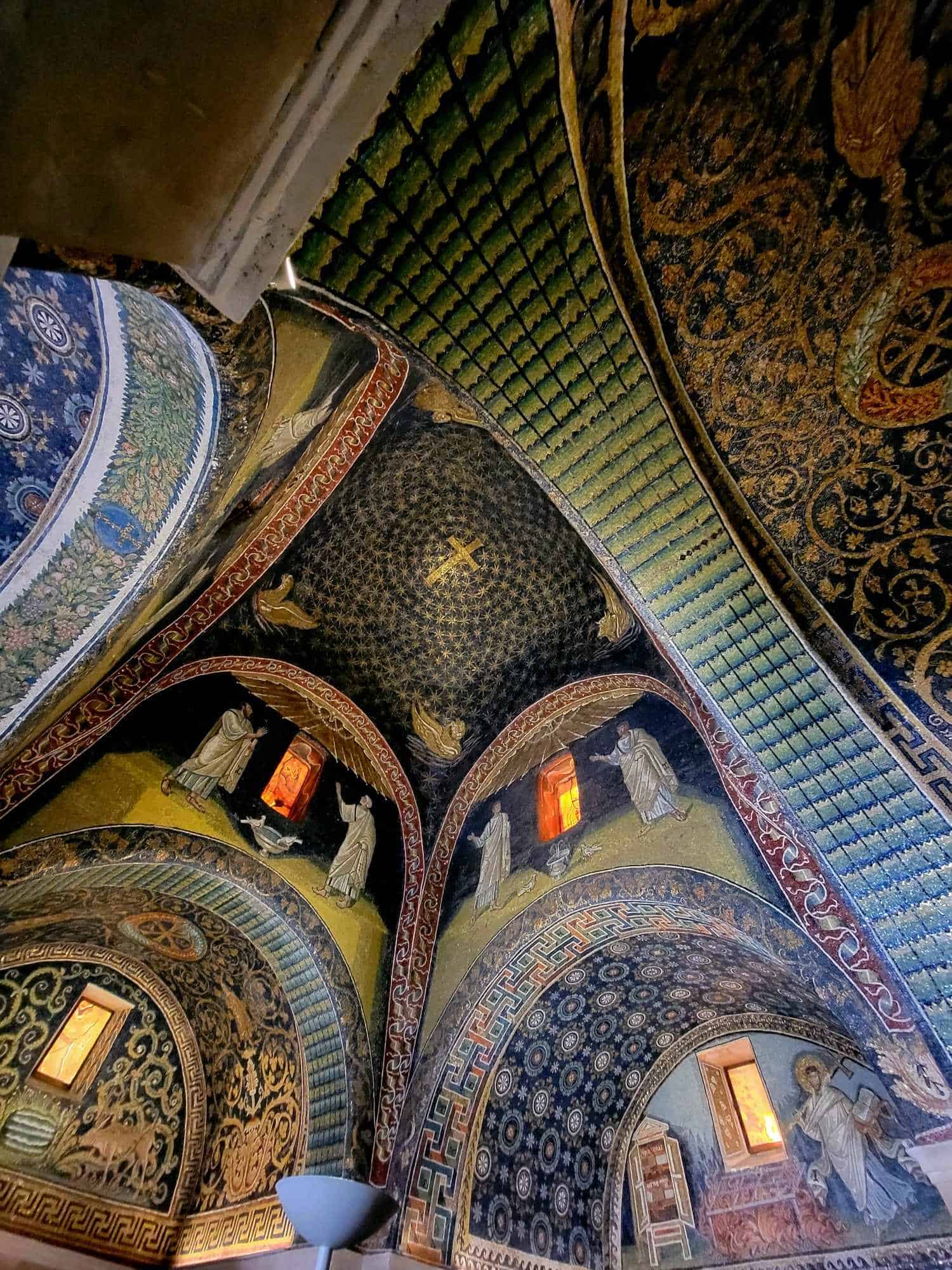Ravenna in one day? This city on the sparkling Adriatic Coast, is the most magnificent, surprising, and underrated city you may ever visit! Here’s your ultimate one day itinerary (that you can easily stretch to two) for the city that is the home of some of the oldest and most stunningly beautiful mosaics on the planet. It’s also the burial place of the famed Italian poet – Dante!
Ravenna – a city of surprises
Ravenna was a city of lovely surprises. You won’t find it on the usual tourist circuit unless the tourists are there specifically for the mosaics, or because they are Dante aficionados. This makes Ravenna a little slower-paced than Venice, Milan, or even Bologna – the three nearest major cities. We visited in September while the weather was still mild and beautiful, and we found ourselves in an unhurried city with hidden gems on every corner.
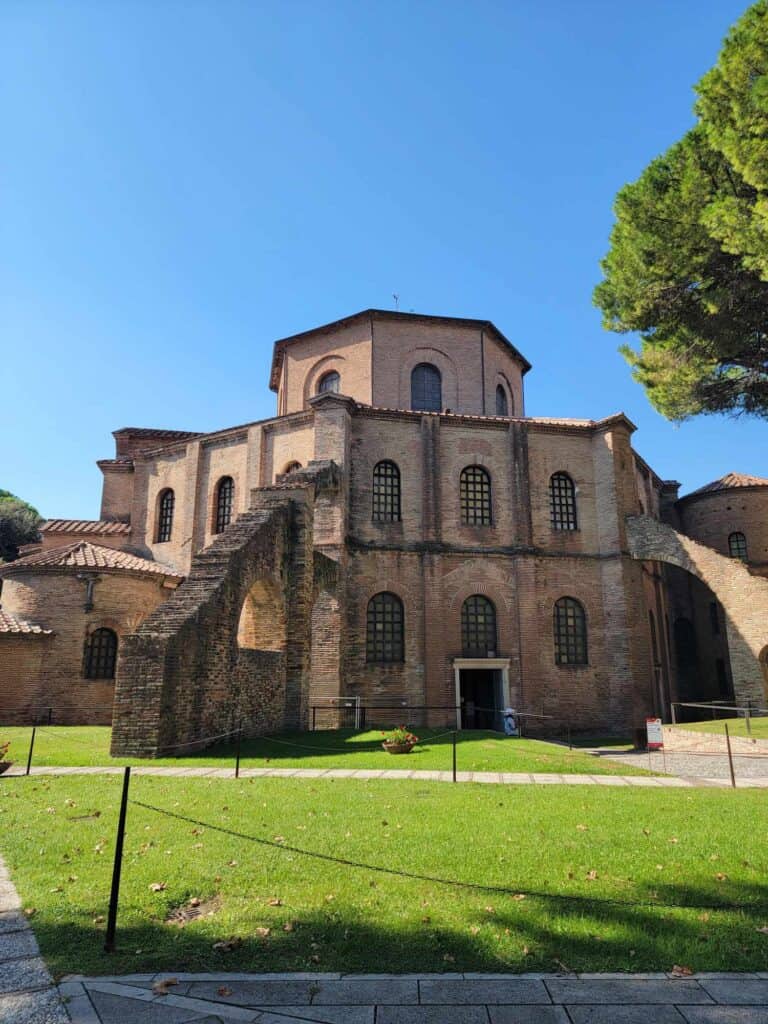
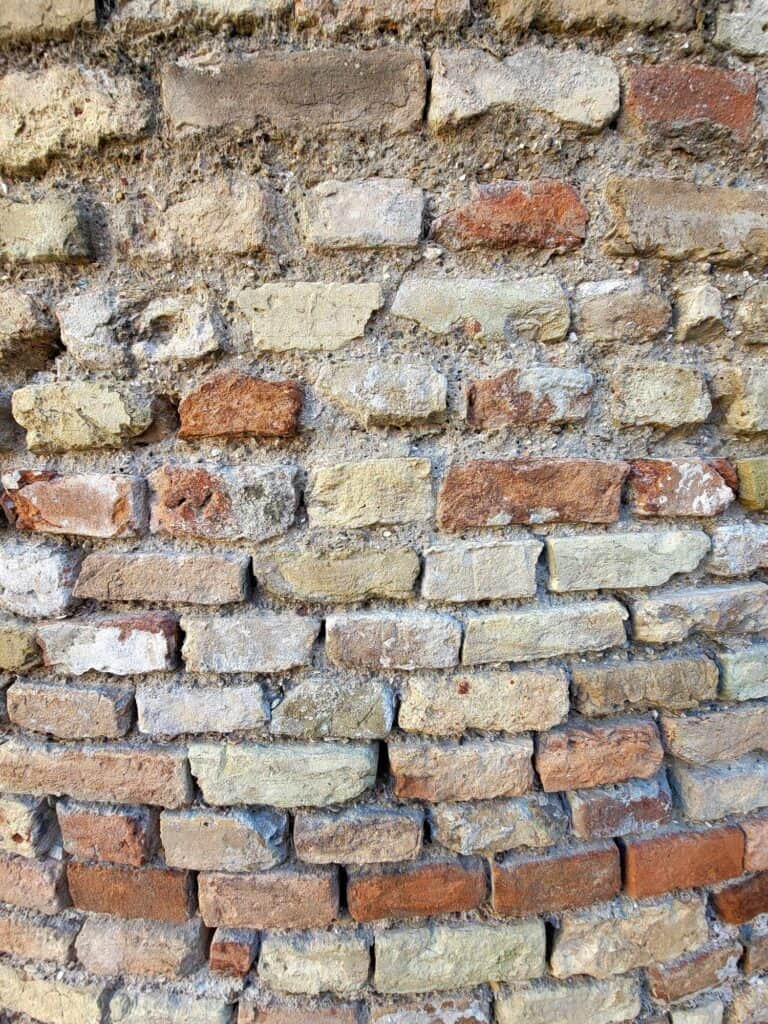
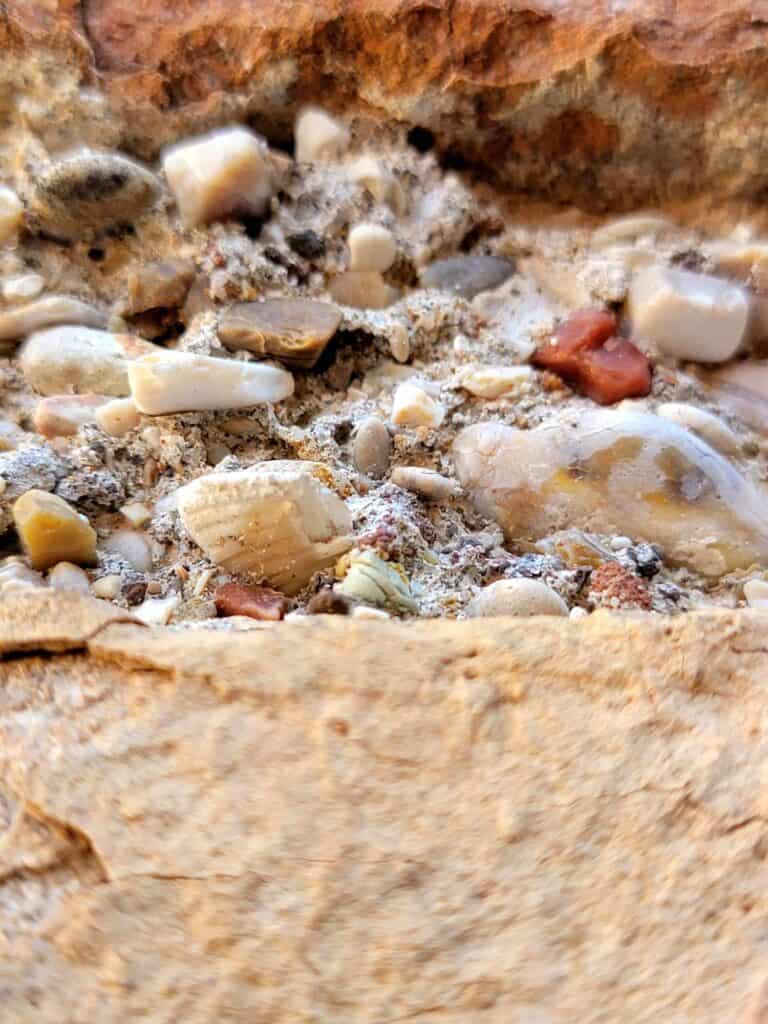
And when I say “hidden,” they really are! The outside of most of the ancient buildings is made of brick, and so plain you might not expect much on the inside. And you would be so wrong! It’s like opening a box of sparkling jewels in a brown paper wrapper. Alabaster windows, Byzantine mosaics, marble and glass, it’s all there waiting for discovery!
Mosaic sites – UNESCO monuments
The thing that does bring tourists to this off-the-beaten-path city is the ancient buildings that house incredible early and beautiful Christian Byzantine mosaics. These intricate and vibrantly colored works of art, dating back to the 5th and 6th centuries, reveal the sacred and secular sides of the city. Saints, Emperors, Biblical figures, wildlife, geometric patterns – all stunningly portrayed in tiny pieces of glass and stone.
What are the mosaics in Ravenna made of?
Most of the mosaic pieces measure only about a centimeter square, fashioned either from stone or glass. You’ll see only stone used on the floor because of its resistance to damage from foot traffic. The colors are therefore dependent on the natural pigment of the stone – red jaspers, green serpentine, and a whole host of different marbles from black, to yellow, red, grey, and white. The glass mosaics were costlier to make, relying on pigments like lapis lazuli powder for blue, and real 24-karat gold leaf applied to the hot glass.
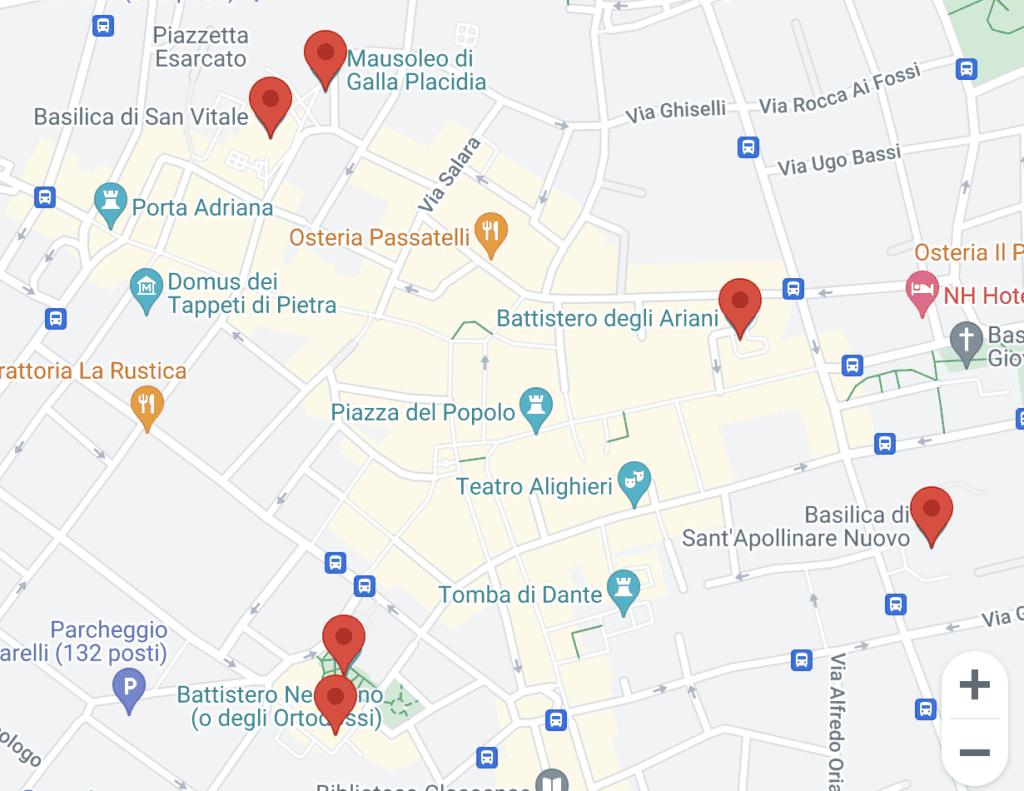
UNESCO designation
Of course, some restoration has occurred in the last 1500 years, but a surprising amount of this glittering, mind-blowing art is original. If you’re thinking you’re really not that into mosaics or early Christian art, don’t write this place off.
The sheer sumptuous, immersive experience in these spaces transcends anything you can imagine. These magnificent sites are of so much importance culturally and historically, they have been given UNESCO world heritage designations. All in all there are 8 UNESCO monuments in Ravenna. Most of the sites are very close together, and if you need a one day itinerary for Ravenna, you’ll want to focus on four to six of these sites. Unless all you do is see mosaics, it’s not realistic to see them all and really appreciate them in one day.
The tour we booked to see the mosaics
Because of the sheer magnitude of what we wanted to see in Ravenna in one day, we opted in to the guided tour instead of trying to figure it out on our own and it was totally the right call!
We made it to many of the sites, but not all. If the mosaics and their history are your only focus, then here’s the link to all of them.
We went through Get Your Guide, and took this tour. It began at 10:10am and allowed us to grab breakfast and a coffee at the Caffè Pasticceria Palumbo right next to the tourism office where you pick up your ticket. Tickets were about $30 per adult and worth it. The tour lasted for an impressive 3 hours, and was packed with information. It also came with an audio amplifier so you could clearly hear the guide speaking.
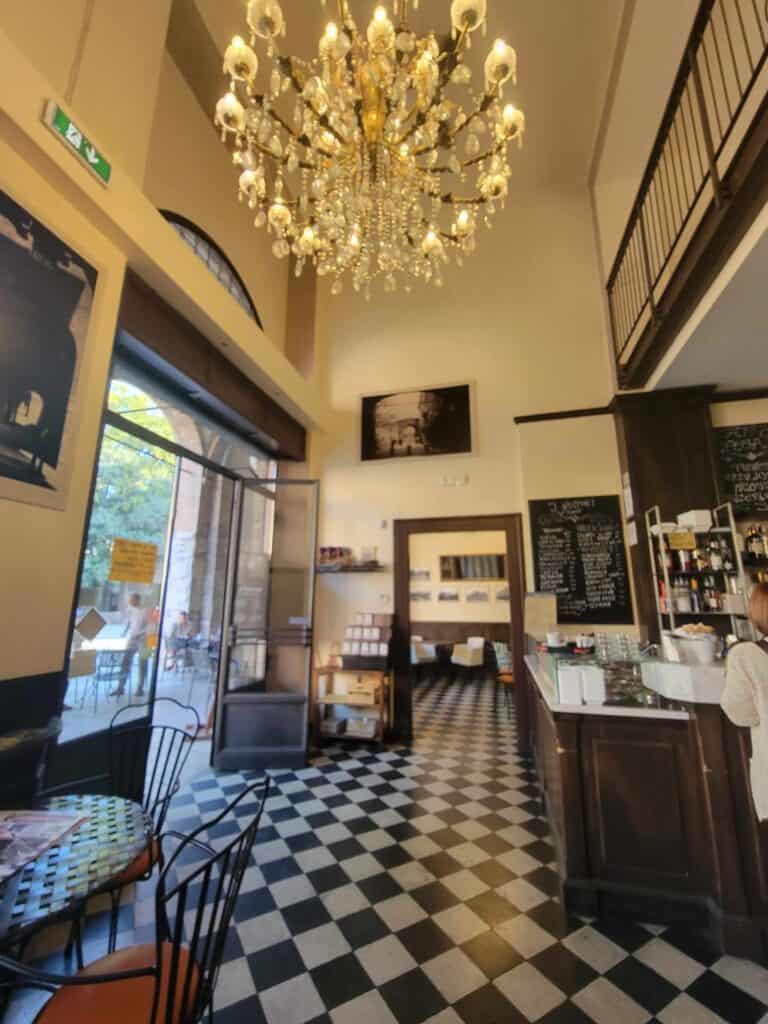
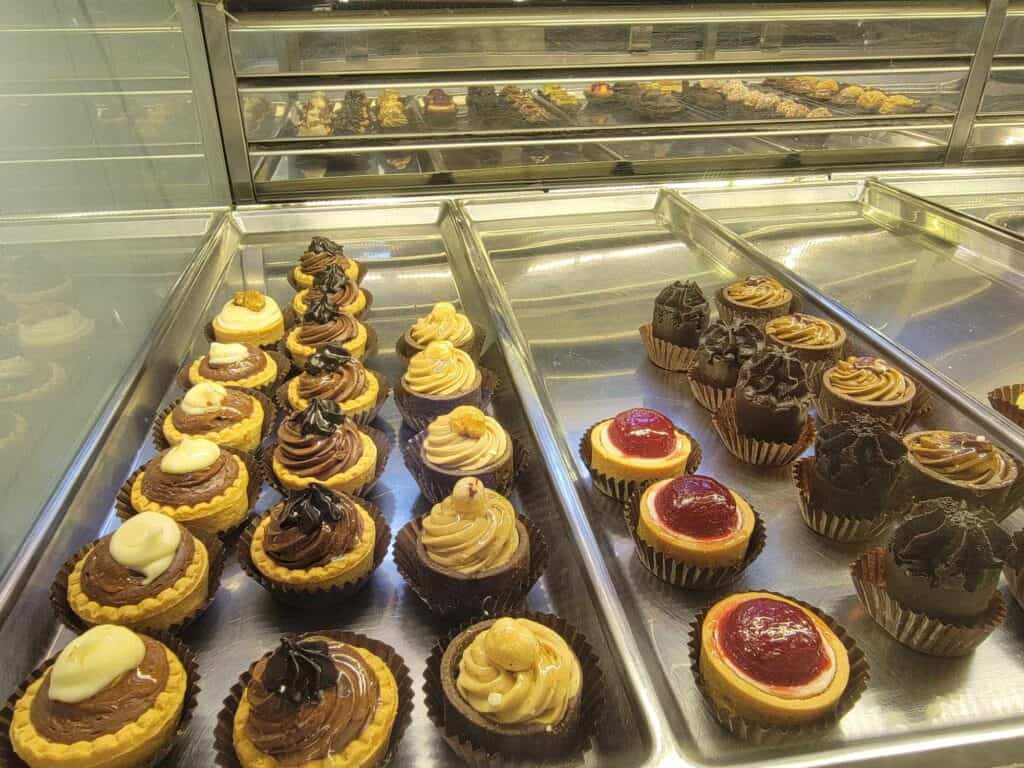
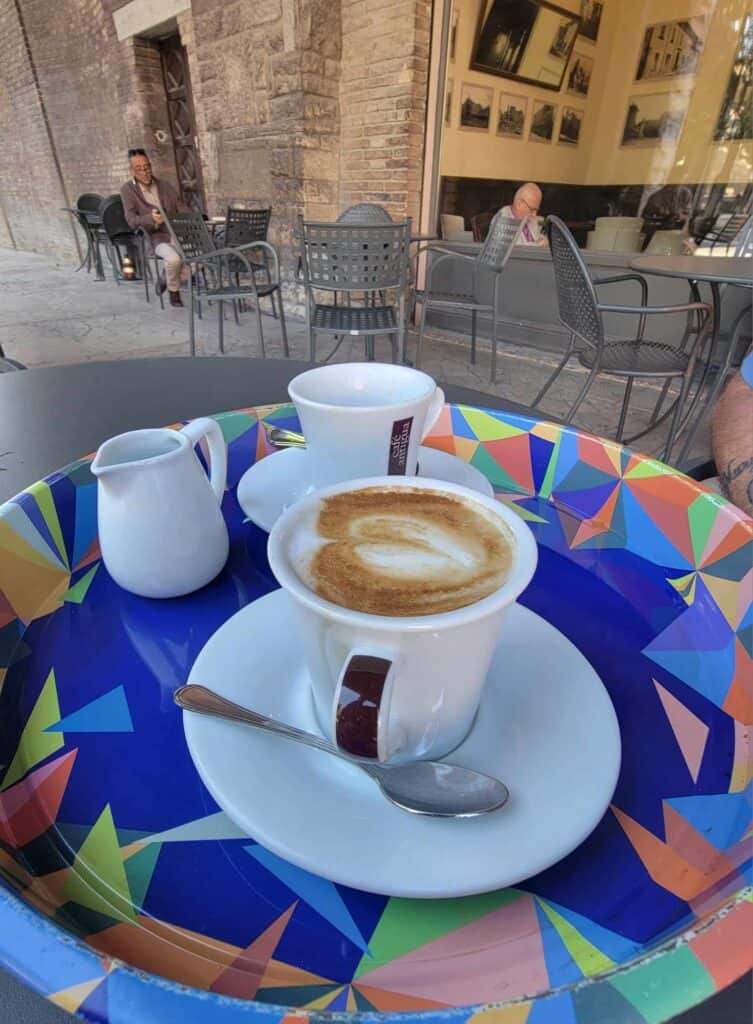
Basilica of San Vitale
Talk about a show stopper. I could have spent a great deal of time here… like hours. Everywhere you look it’s a marvel. The marble floors, the golden ceilings, the detail and precision with which this was created is unfathomable. Part of the basilica features the baroque style which makes it a little of a design mishmash, but in the best possible way. It’s a feast for the eyes. You could basically drop your phone and get a fantastic picture.
The fact that this sixth century basilica has survived makes it a true historical gem of Byzantine art and architecture.
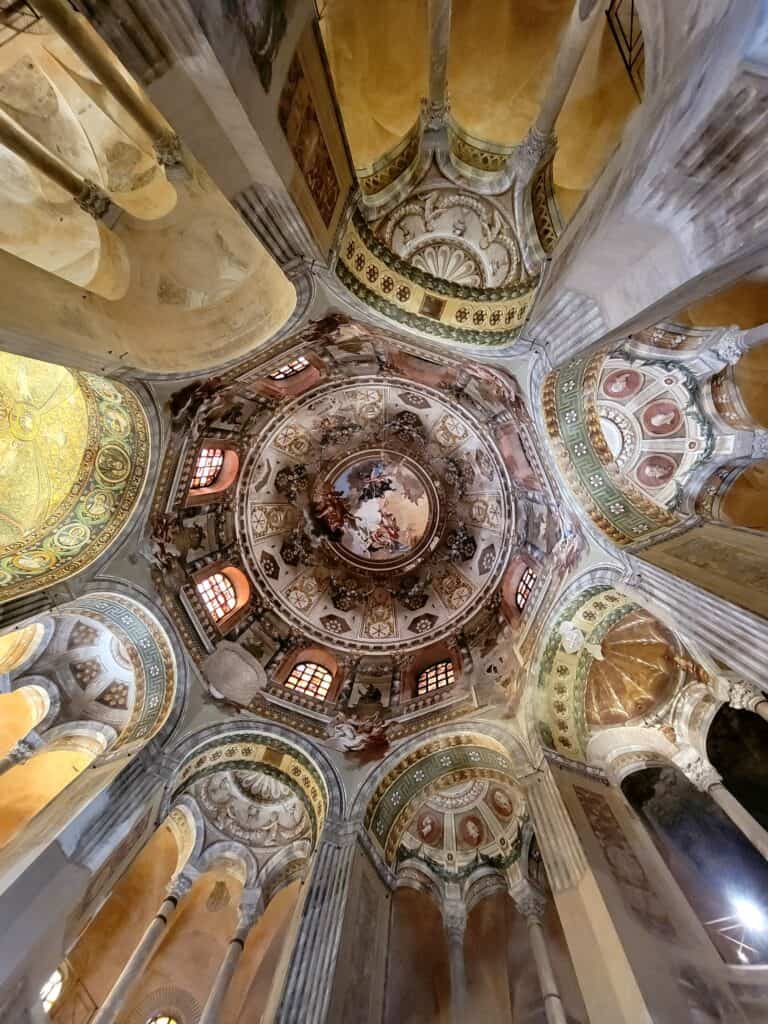
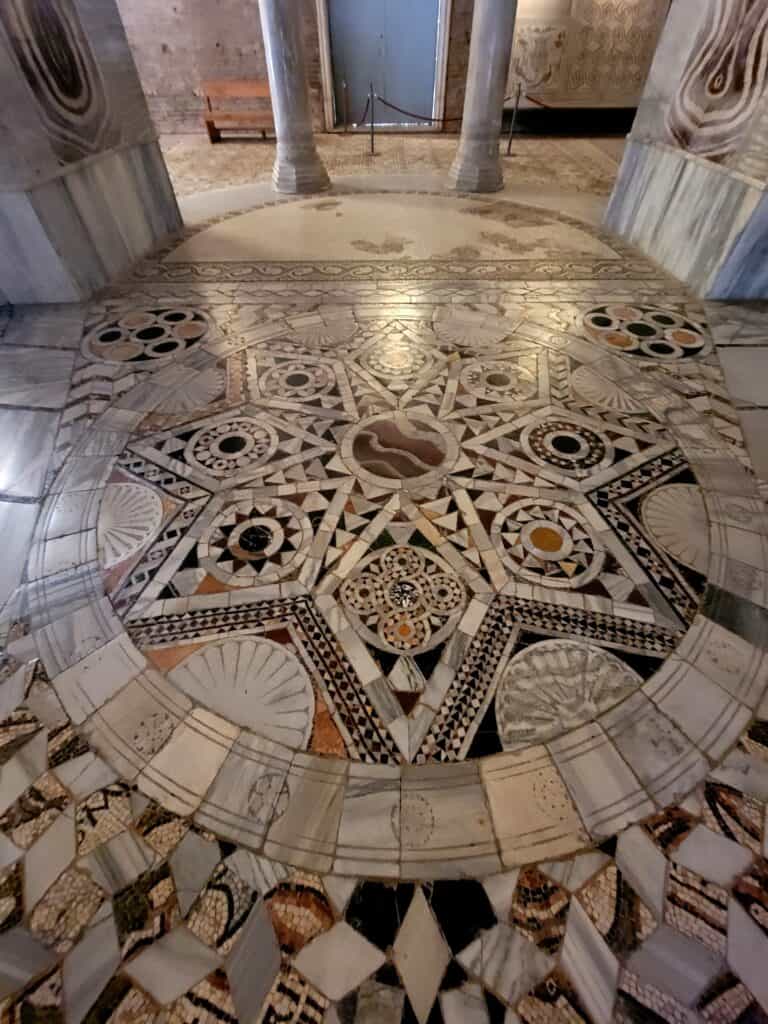
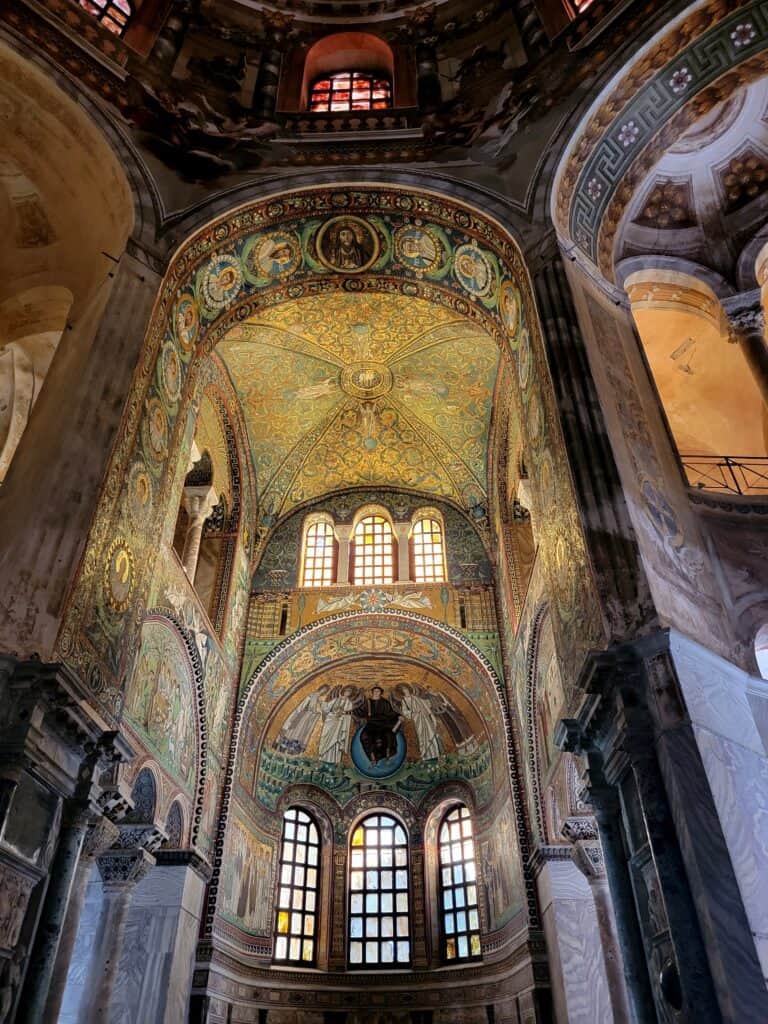
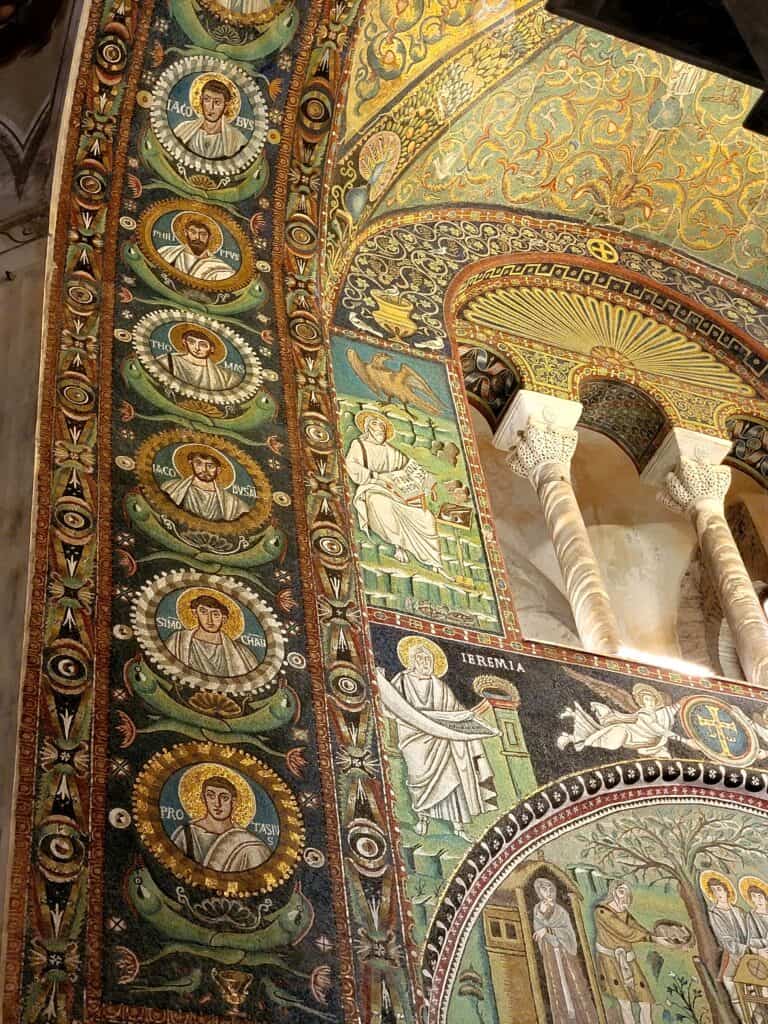
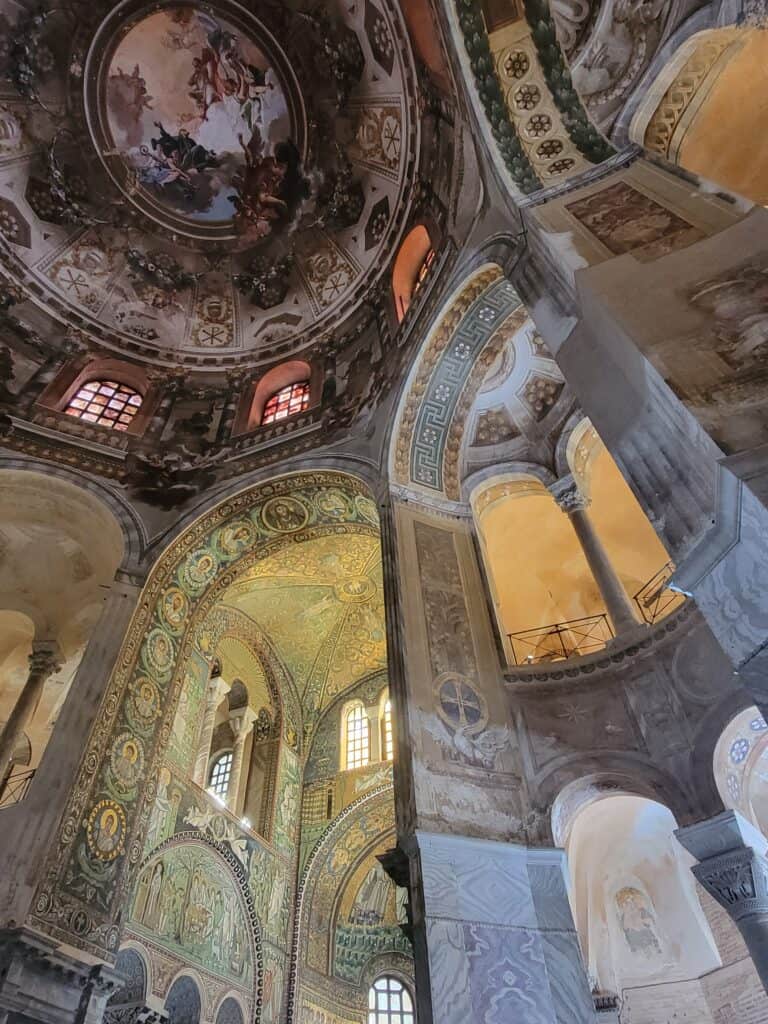
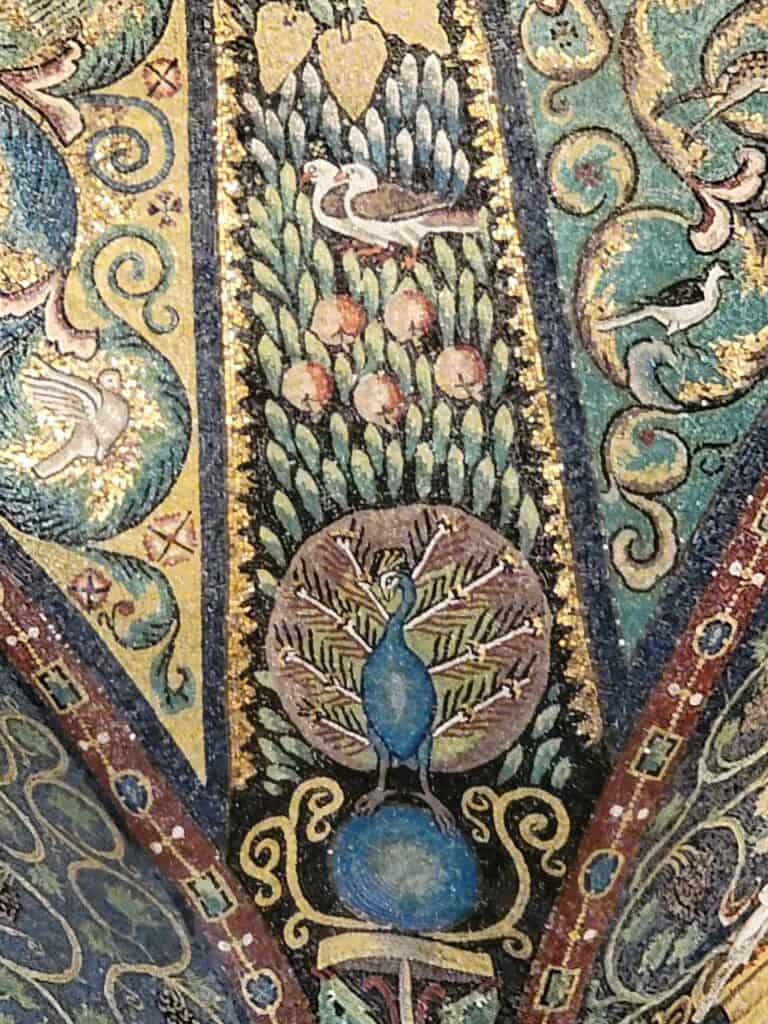
Mausoleum of Galla Placidia
Even though the Mausoleum of Galla Placidia is much smaller and more intimate than the Basilica of San Vitale, the wow factor is just as intense. Only small groups are allowed in, and you’ll only have five minutes here. That’s ok because you will never be fighting crowds and every second you have can be spent in full appreciation of what you see. Do all your reading up on this place beforehand because when you are inside, your job is to just gaze and stand in awe.
Galla Placidia was the last Roman Empress, and a brave, educated, and strong woman. You can read up on her history HERE. The building, commissioned by her, is unforgettable with its stunning canopy of golden stars sprinkled on a deep blue background. These glass tiles gain their hues from lapis lazuli, and gold. The moody light inside comes from the window panes which are made of alabaster, and create a warm magical glow. The photos I took, while they do serve to remind me of my visit, don’t do justice to the actual experience. You will have to do it yourself and you will be glad you did!
Book the same tour of Ravenna’s mosaics and UNESCO sites we did!

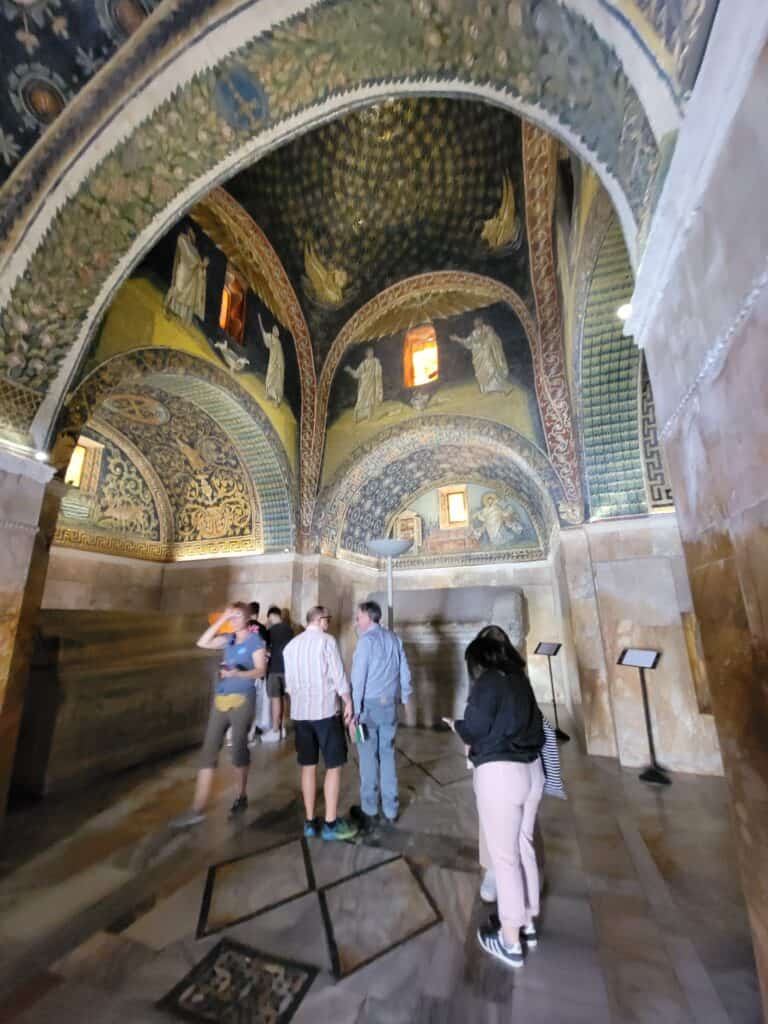
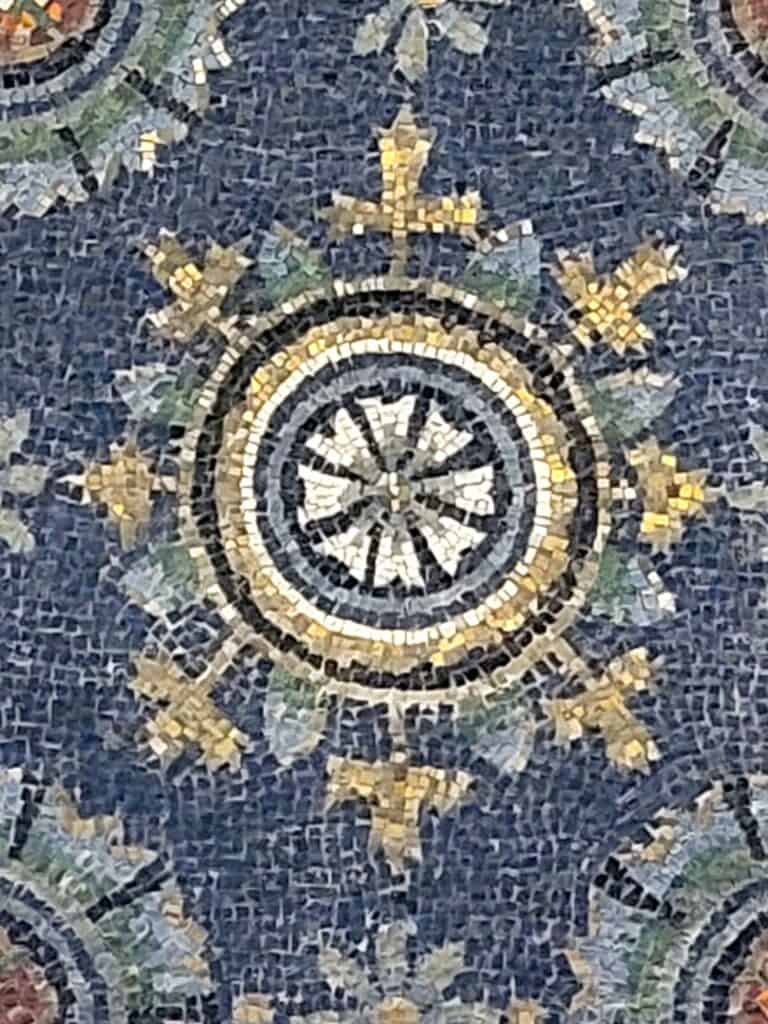
Basilica of Sant’Appolinare Nuovo
This incredible work was done mostly in the time of the Theodoric, and Justinian. They had theological differences of opinion about the Christian trinity – Theodoric on the “God is the main one” side and Justinian on the “Holy Trinity” side. I don’t claim to be an expert on esoteric Christian themes, but suffice it to say that this difference of opinion led the Arians to be considered heretics eventually, and there were mosaics of theirs that were “erased” by Justinian and remade with different iconography.
One could spend a great deal of time studying all of this. Our guide, Isabella, knew everything about everything and patiently answered every question, of which there were many from our group. I confess to occasionally following some glittering starry sky, or wandering off to look at marble inlay and missing out on some of it, but truly part of the joy of these places is allowing your senses to just experience the beauty of it all.
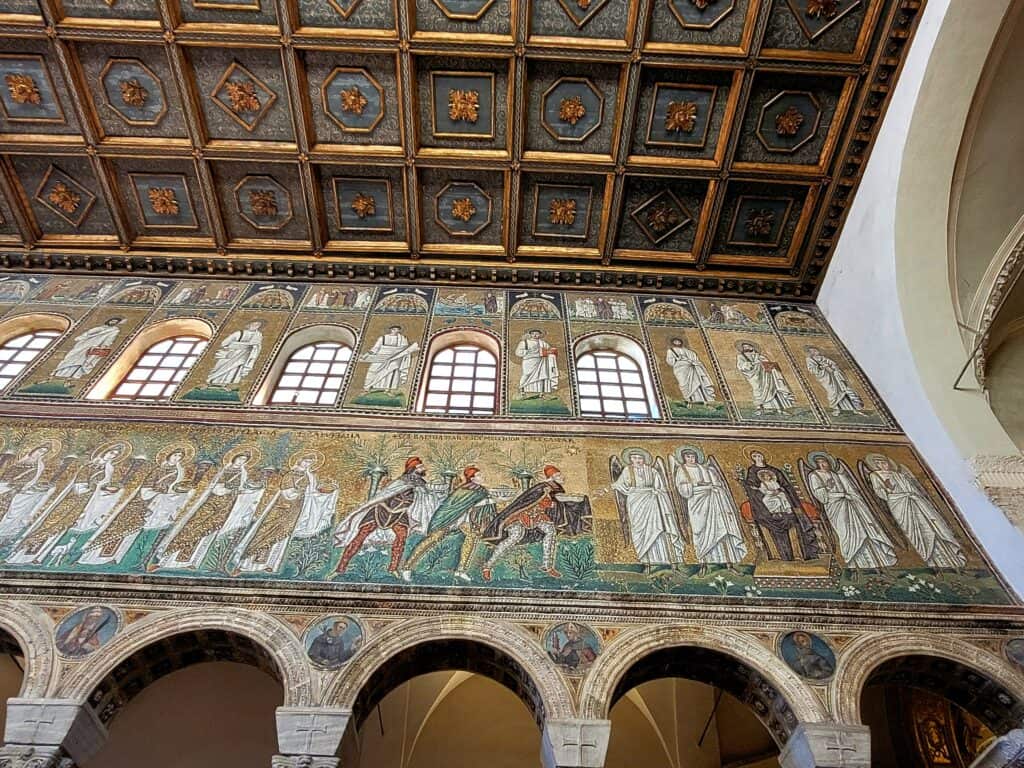
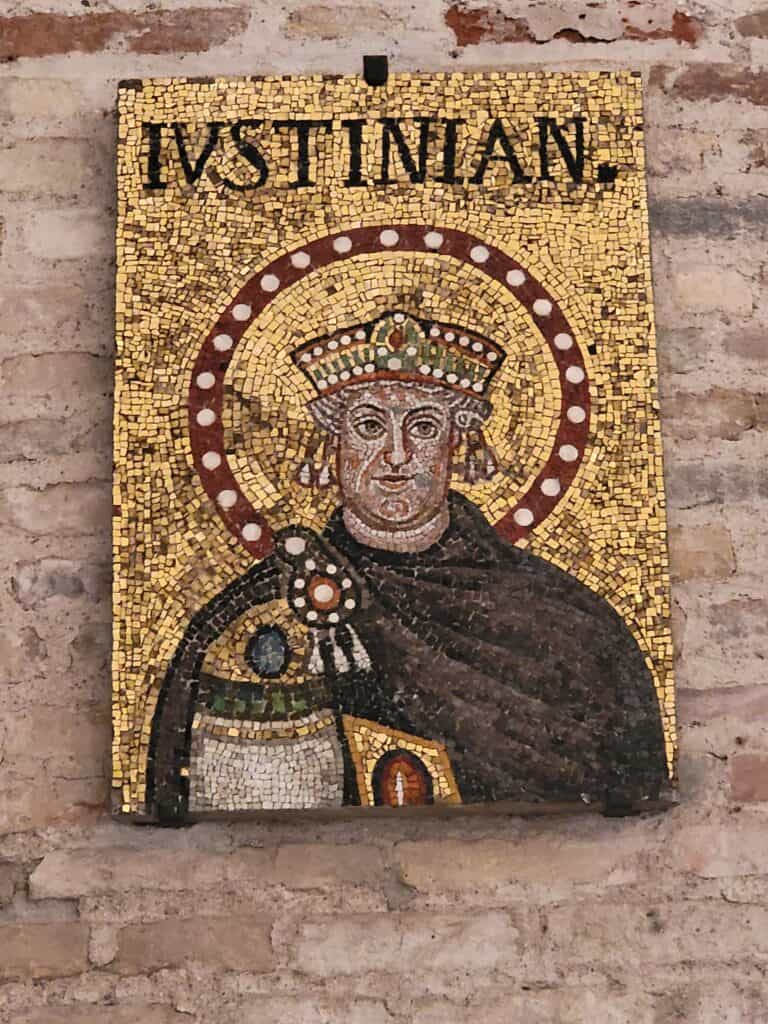
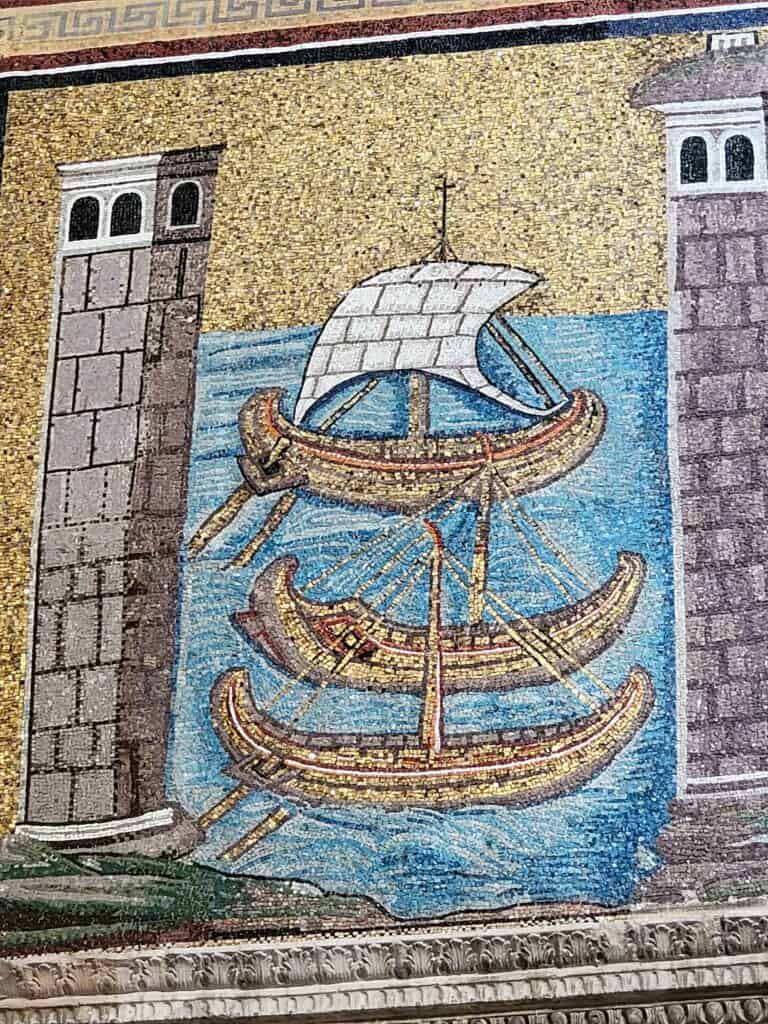
City of Dante
Ravenna is also the final resting place of renowned poet and author Dante Alighieri. He ended up on the wrong side of a theological feud in Florence, and while visiting the Pope in Rome, all his belongings were seized, and he was accused on trumped up charges of taking political bribes. When he didn’t show up for trial, he was sentenced to burn at the stake. He chose instead to spend his last years traveling northern Italy, staying with friends and patrons. I, too, would rather spend my remaining days couch surfing in Northern Italy than being burned alive!
He eventually came to live in Ravenna, under the protection of its ruling family, the Guidis. It was during his final years in Ravenna that he completed his masterpiece of literature, The Divine Comedy.
Dante’s Church
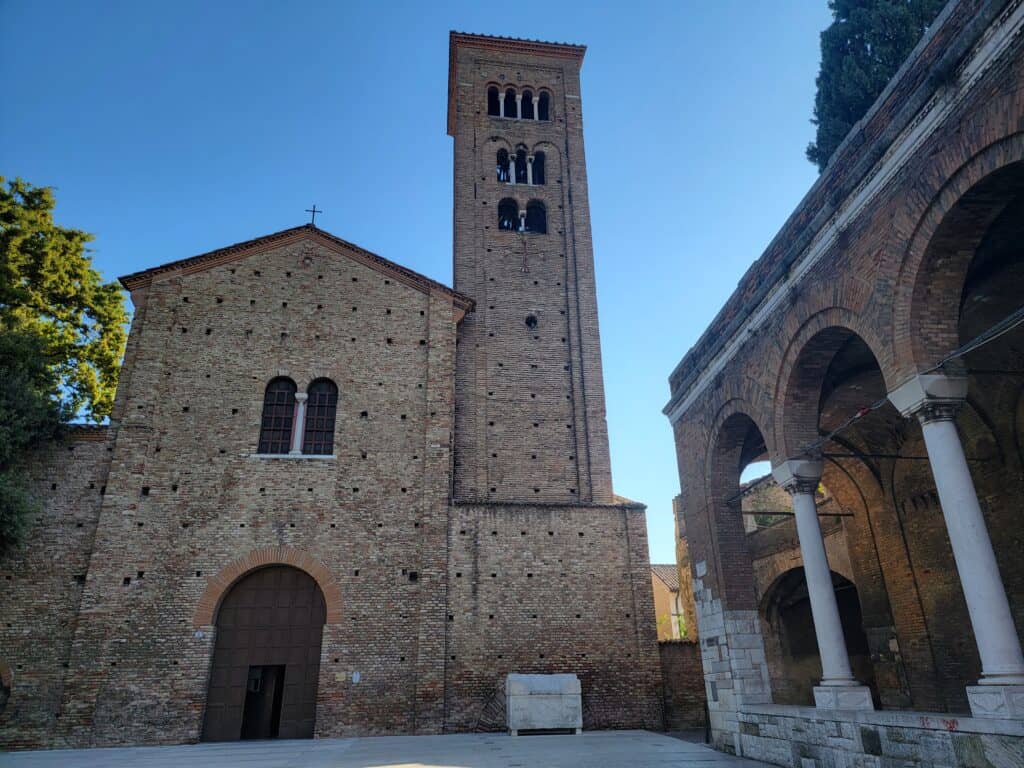
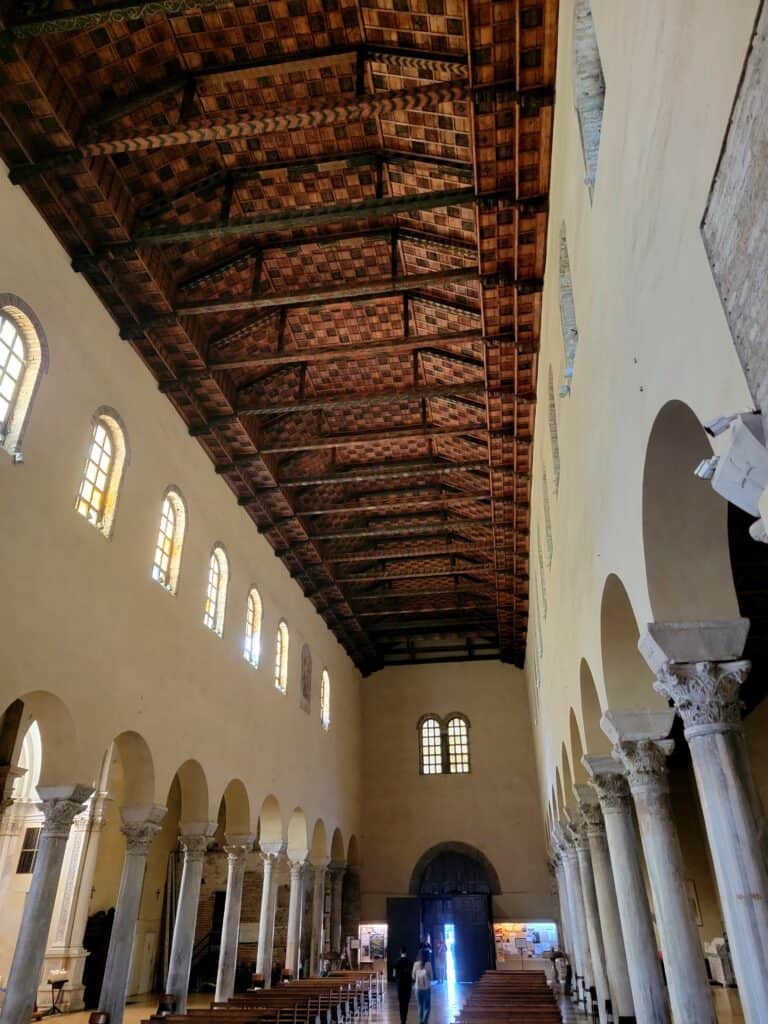
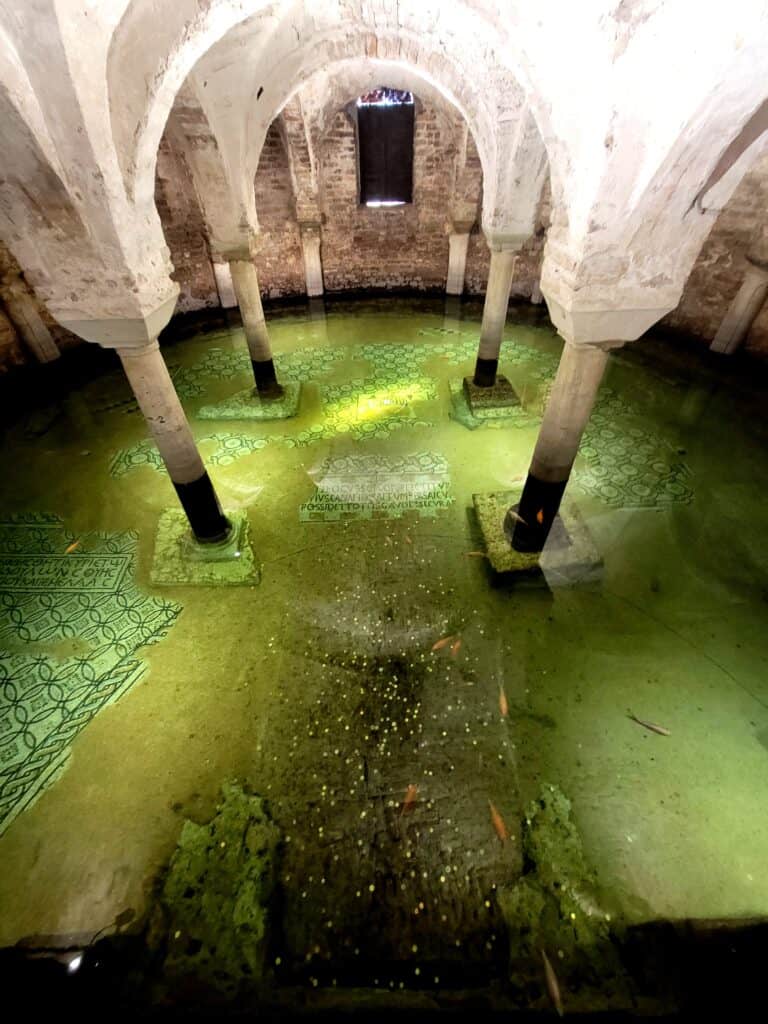
This was the first stop on our tour, because the Basilica of San Francesco is located adjacent to that fabulous coffee shop I posted about above. For any literature lover, this one is sure to give you goosebumps. All I could do was imagine what Dante’s funeral must have been like in this very spot in 1321 when the city who had given him refuge mourned.
There are no mosaics on the walls, but the space is beautiful with a couple interesting features of its own. The first thing you will notice is the incredible ceiling! It almost looks like a woven basket. And the high clerestory windows are made of alabaster. Just wow.
And up by the altar, there is a definite “did not see that coming” moment. Our guide dropped a Euro coin into a little slot, and the lights came on to reveal the crypt, flooded with seawater, and fish swimming over fragments of mosaic flooring. You can see all there is to see in a short amount of time, but it’s definitely worth a pop-in to see fish in a crypt!
Dante’s Tomb
Dante was originally buried in the Basilica of San Francesco, which is very close by. Then in 1329, Cardinal Bertrand du Pouget, nephew of Pope John XXII, declared Dante’s work ‘Monarchia’ as heresy and sought to have his bones burned at the stake. But the people of Ravenna were having none of that, and the monks hid the bones in a box behind a false wall where they faded into obscurity until the 1800s when a brick layer doing some work stumbled across a box full of bones, determined to be of the poet himself. It even said so on the box.
Florence wanted the bones back too, at one point, and even built a magnificent tomb there to house them, but it sits empty because Ravenna said no go.
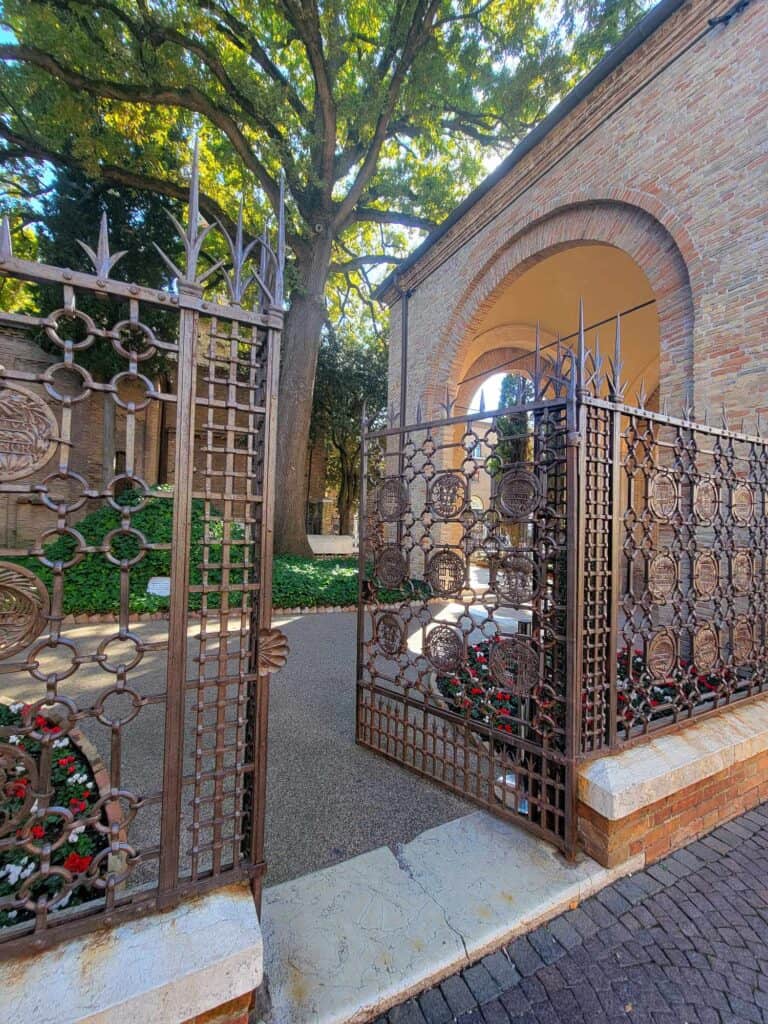
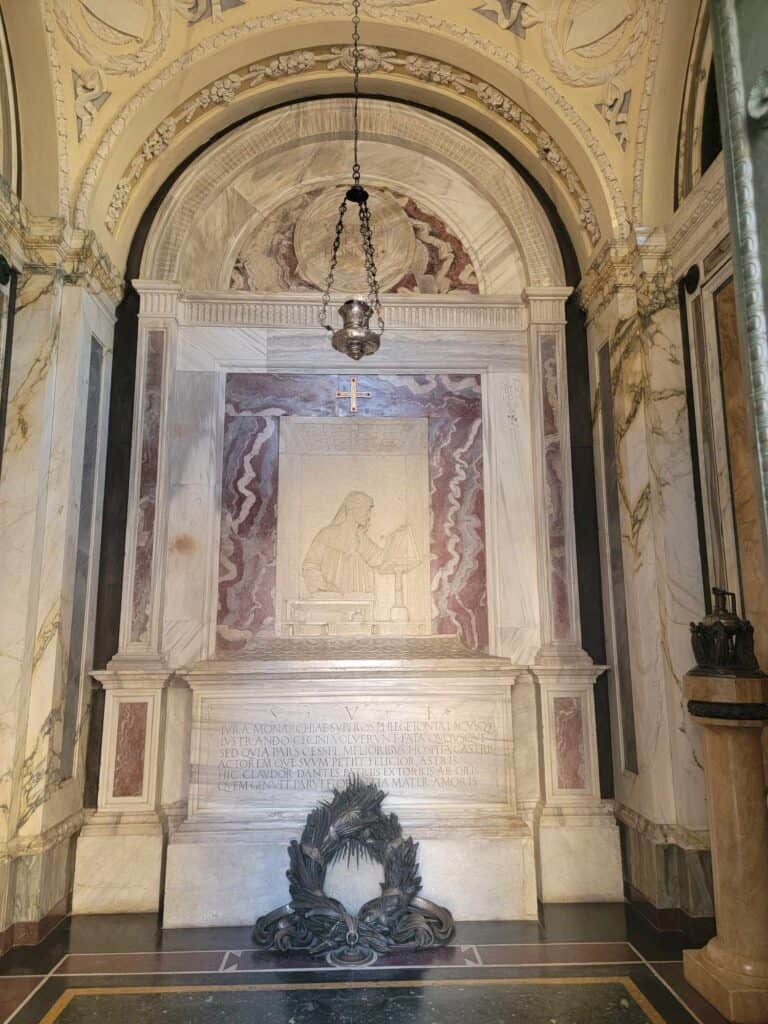
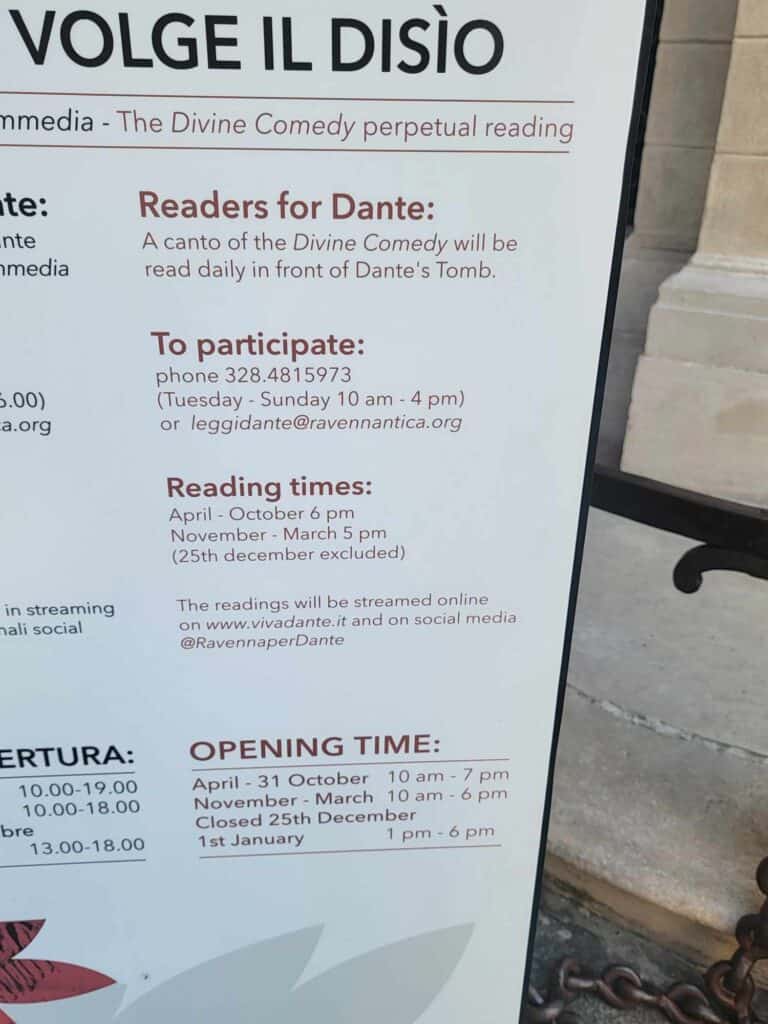
Then in the waning days of fascism in the mid-20th century, Mussollini wanted to abscond with the bones so that when they took their last stand against the Allies, Dante would go with them. That didn’t happen.
Dante’s bones have hopefully come to rest once and for all, and you can visit his tomb yourself. Amazingly, his works will be spoken in perpetuity by volunteers who come every night to the tomb to read a canto from his Divine Comedy. I was very sorry we missed it. We would have rearranged our schedule had we known in advance.
Fun fact: The City of Florence finally did pardon Dante, but not until 2012! Better late than never, I guess? Either way, Florence, you’re not getting him back!
Dante Museum and Library
There is also a Dante library which is absolutely incredible, holding some of the oldest versions of the Divine Comedy and other works. It’s off to the side, and sort of looks like one of those places you’re not supposed to enter. I asked, tentatively if we could go in and the person at the desk said yes, of course! And WOW. Hang on to your hats, bibliophiles, because this room literally gave me goosebumps.
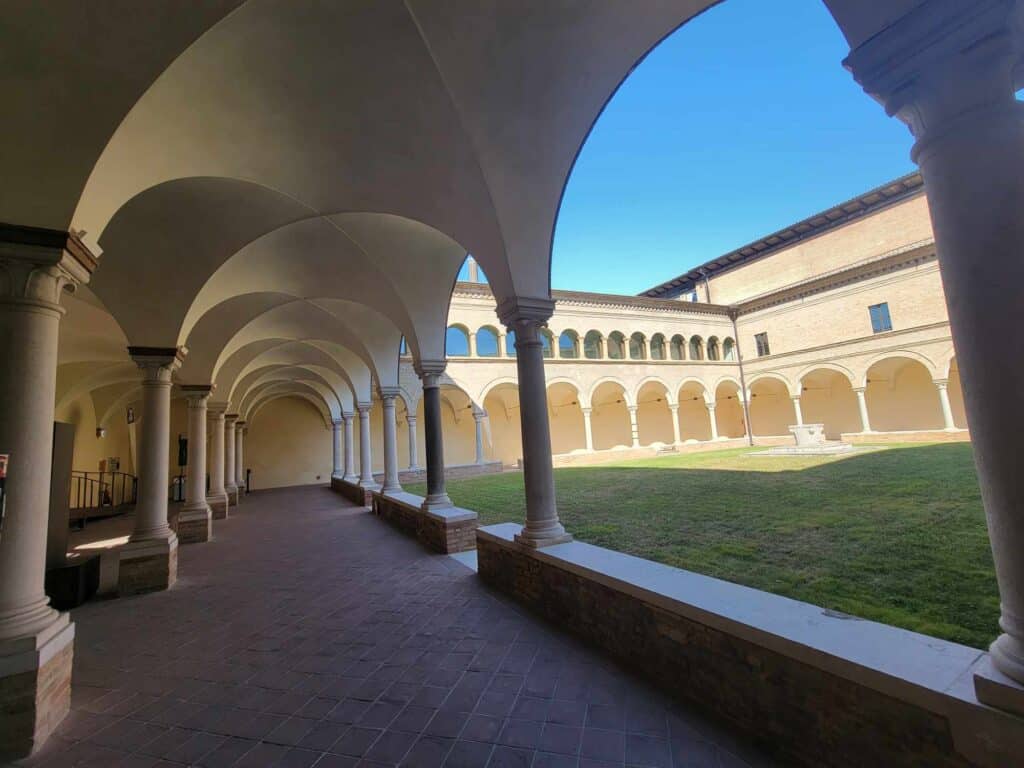
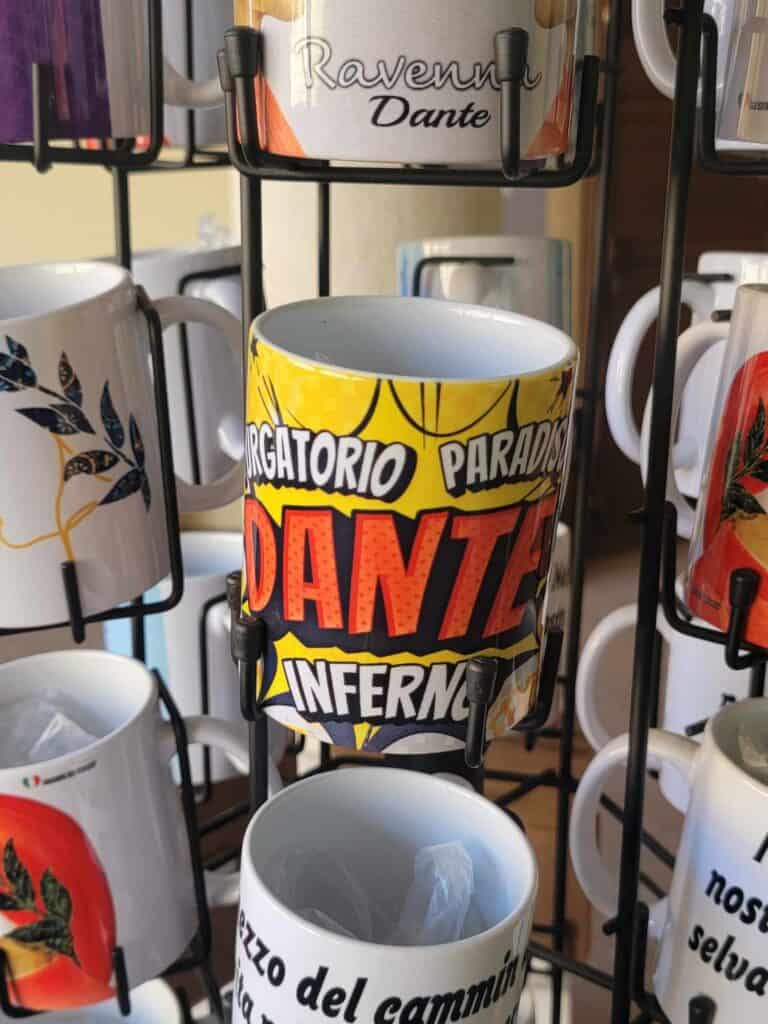
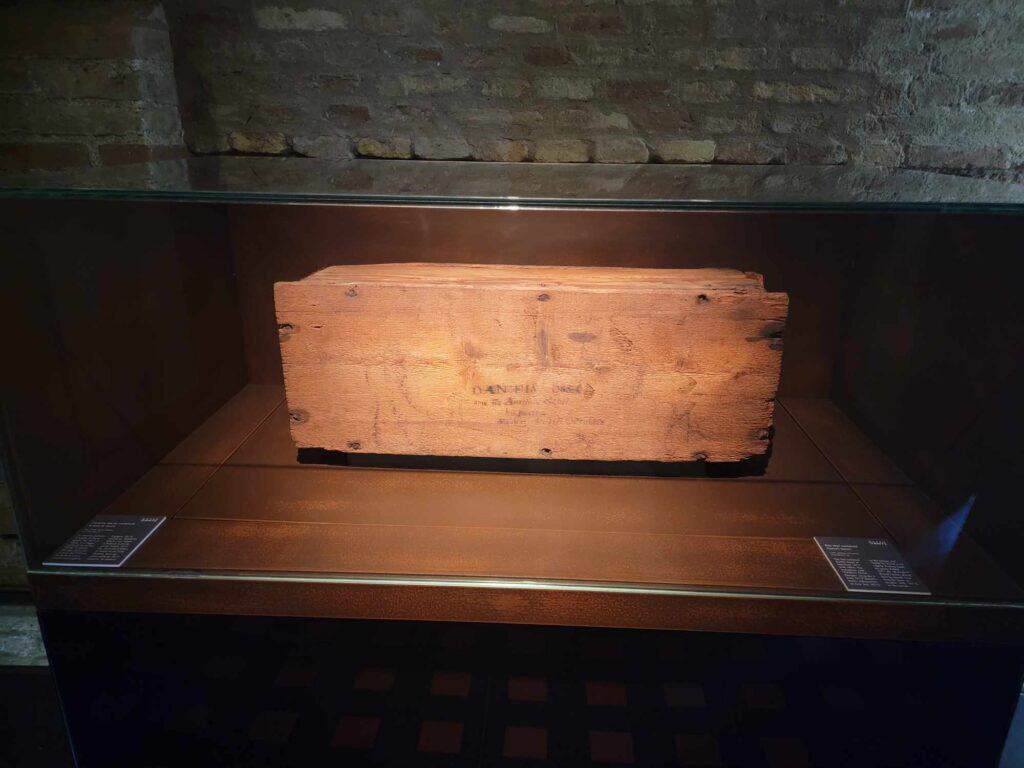
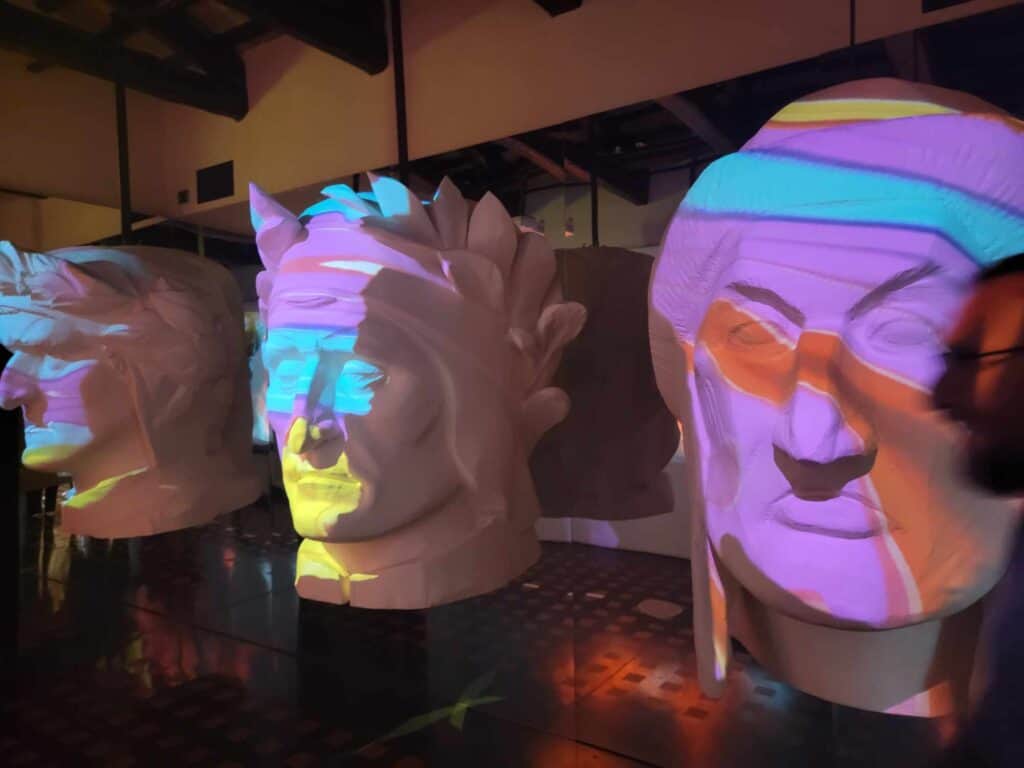
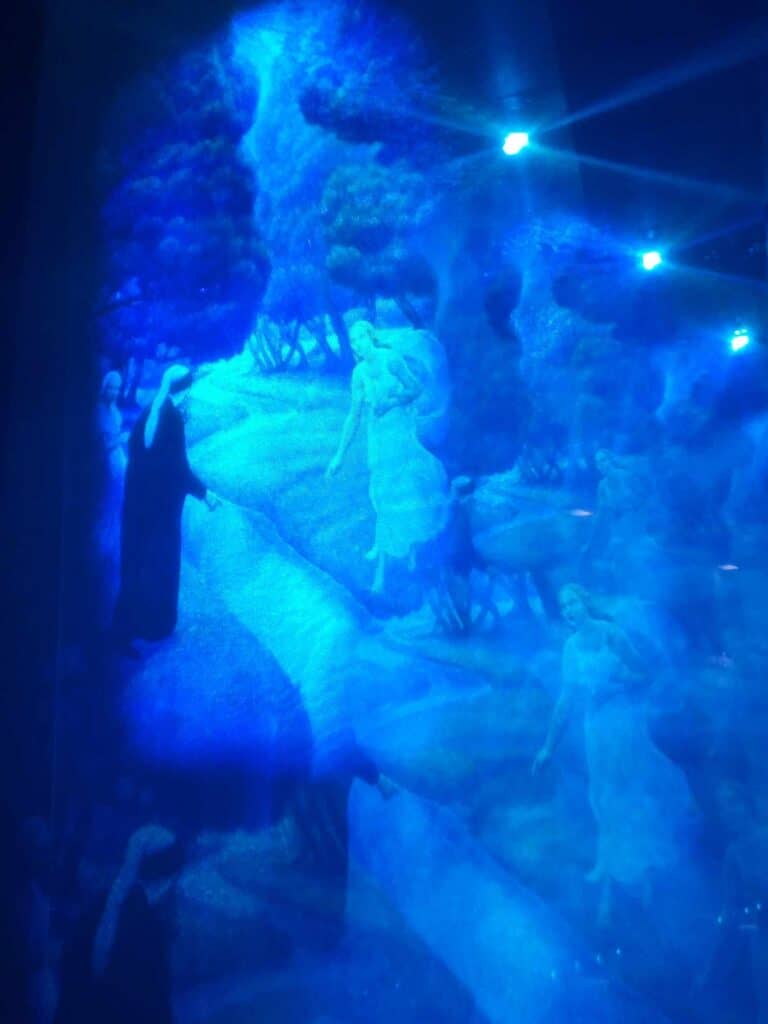
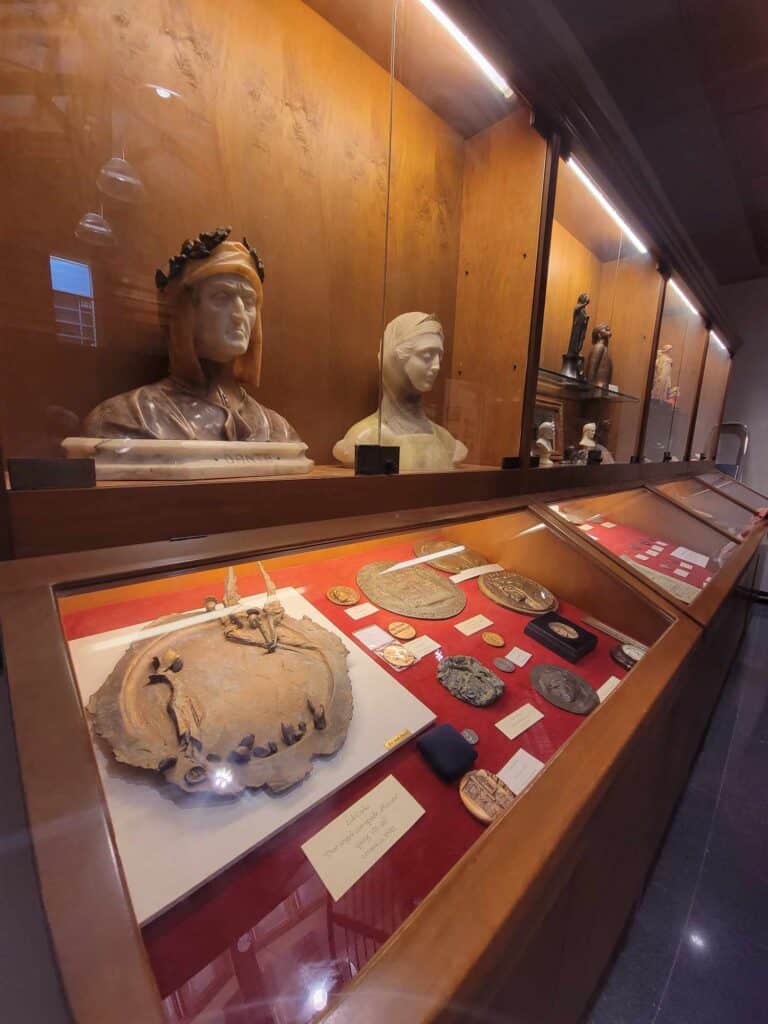
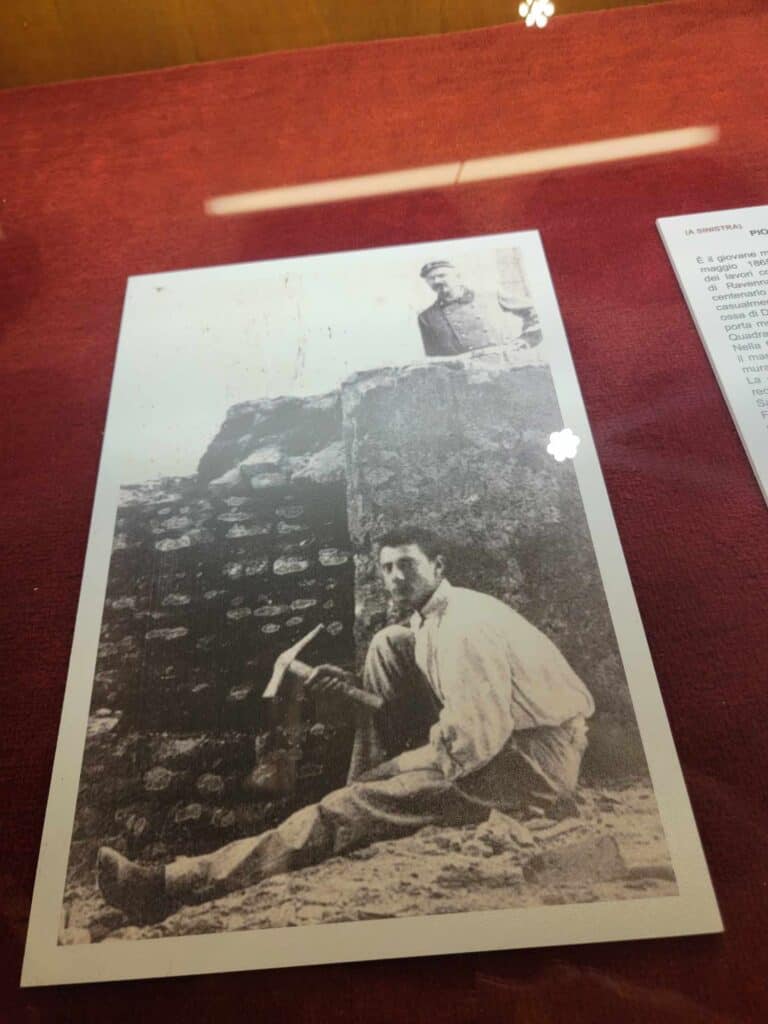
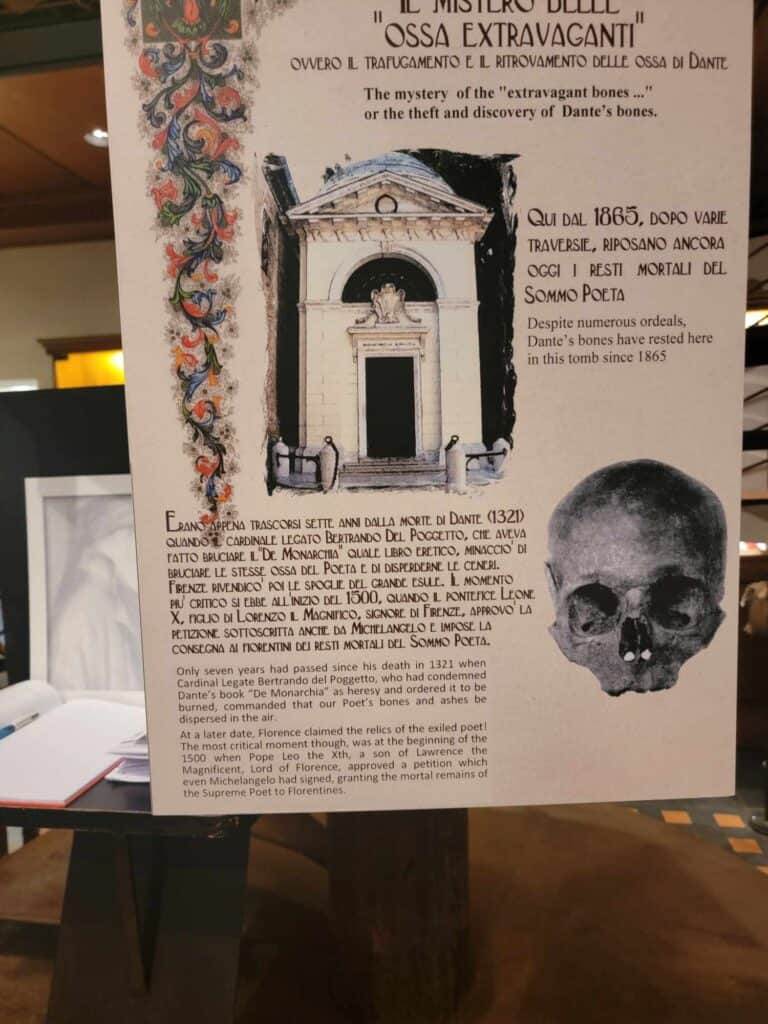
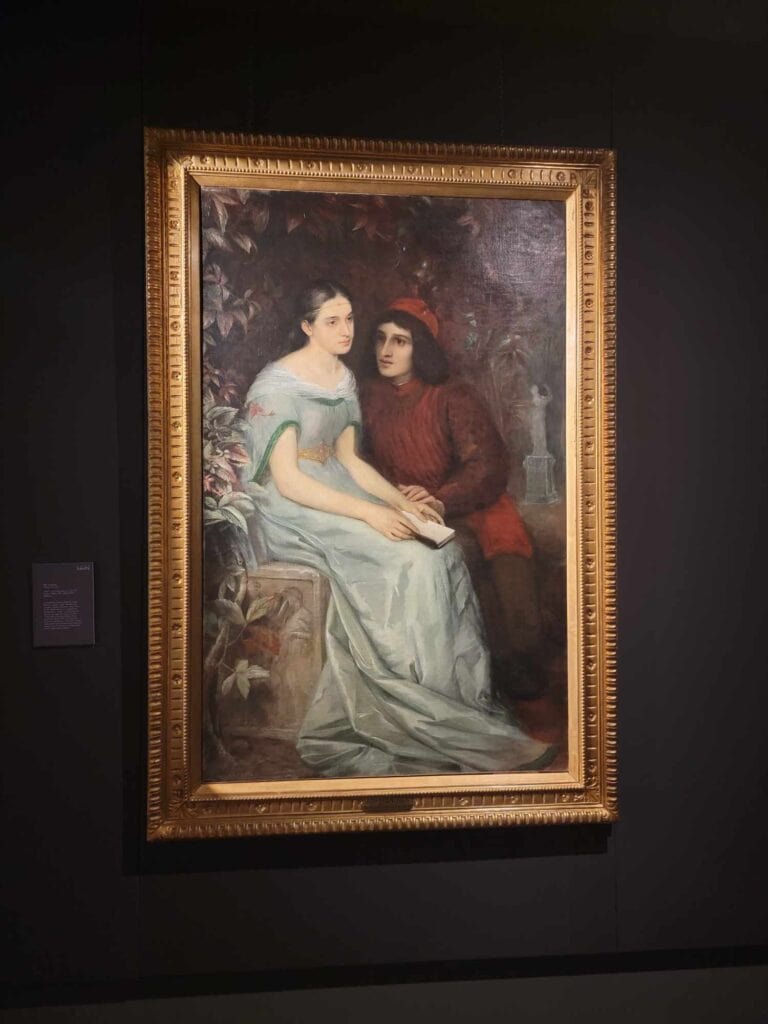
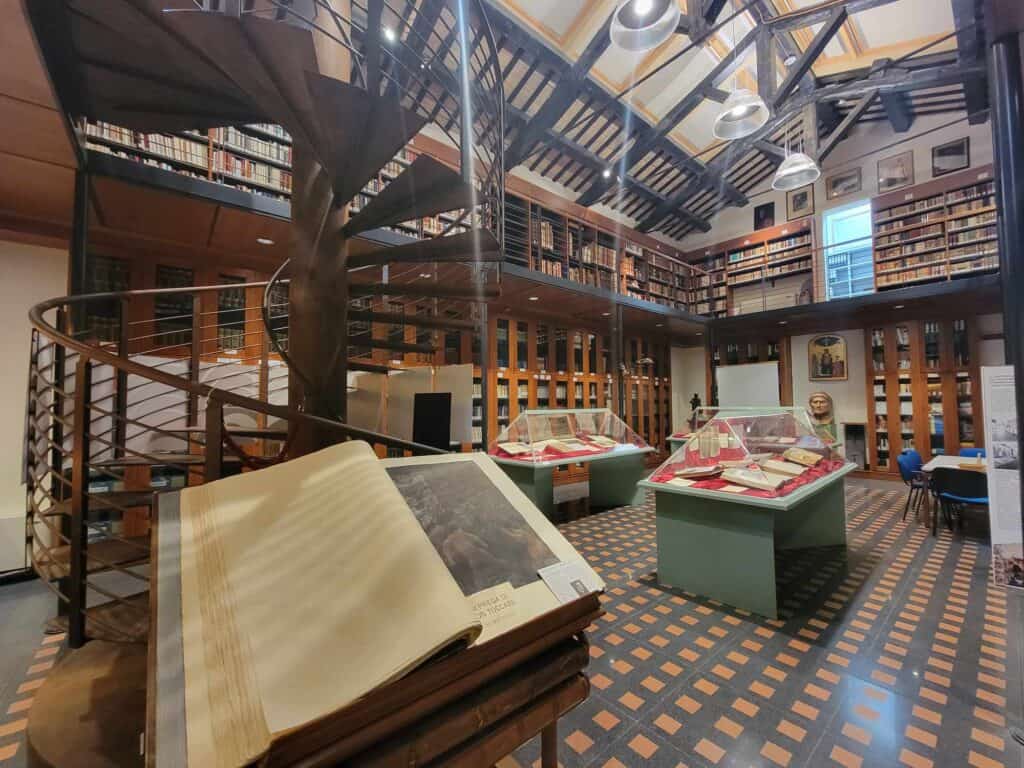
Then there’s the Dante museum, which (like other Italian museums) really likes projected images and light and optical effects. You get to travel through Inferno, Purgatorio, and Paradiso as a deep semi-menacing Italian voice reads from the various cantos of the master’s magnum opus. Very dramatic! There are also other exhibits like the very box that hid his bones! You’ll also see a glass sarcophagus where the bones were displayed before being reinterred. I’m not sure if I can think of another skeleton that’s had such an eventful time!
Overall, though, it’s tough at times for English speakers as most of the material and the audio is only in Italian. Worth a visit nonetheless, and you can wrap it up in an hour easily.
Adult admission is about $5 and is accessible for people with disabiities.
Hit the Gift Shops
The gift shops in Ravenna are great. Of course there will be the usual touristy stuff, but keep your eye out for some really incredible mosaic art! The large pieces are pricey. The one I really wanted was almost $2000, so we made do with a smaller version that still makes me smile every time I see it.
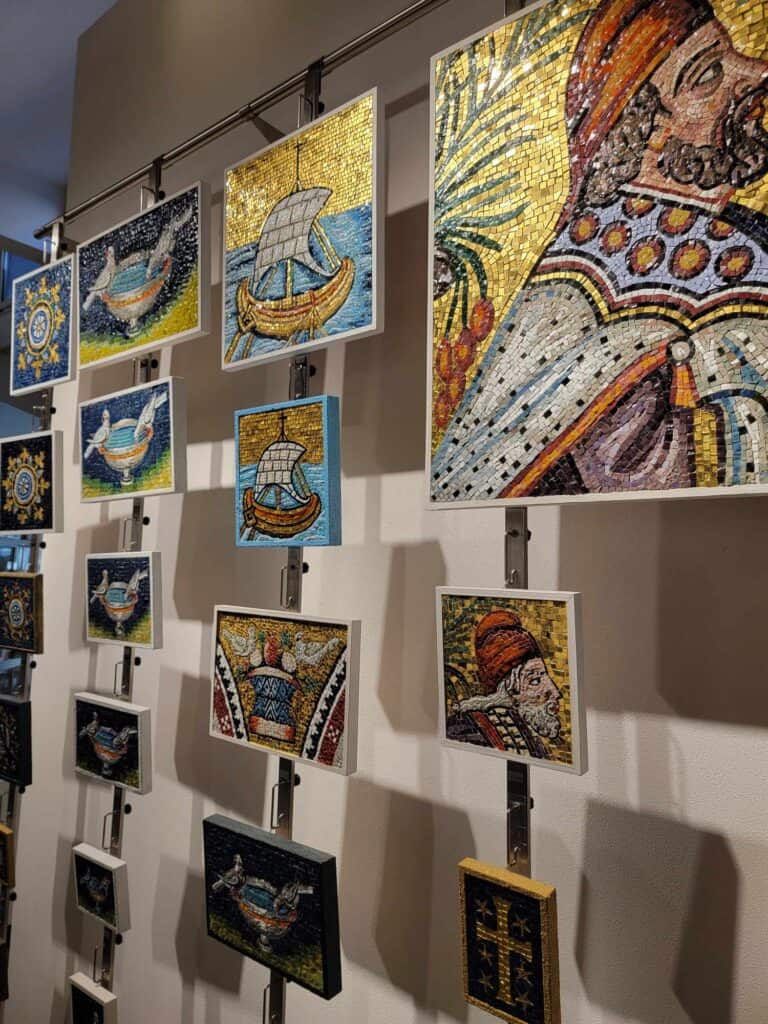
Stop by the Beach and the Marina
If your eyes and your brain are on visual overload from all you have seen, a quick drive from the old town east brings you to the beach! The little shops and people give the vibe of a fun but laid-back seaside community. The marina holds everything from put-put motorboats to huge luxury yachts – motor and sail.
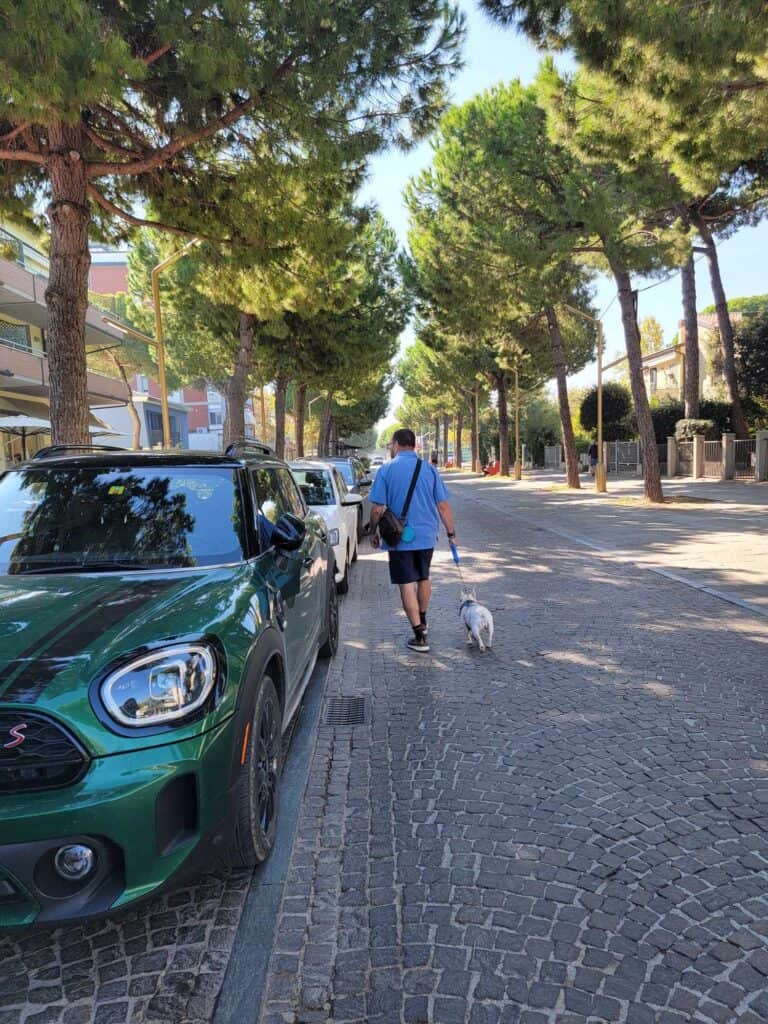
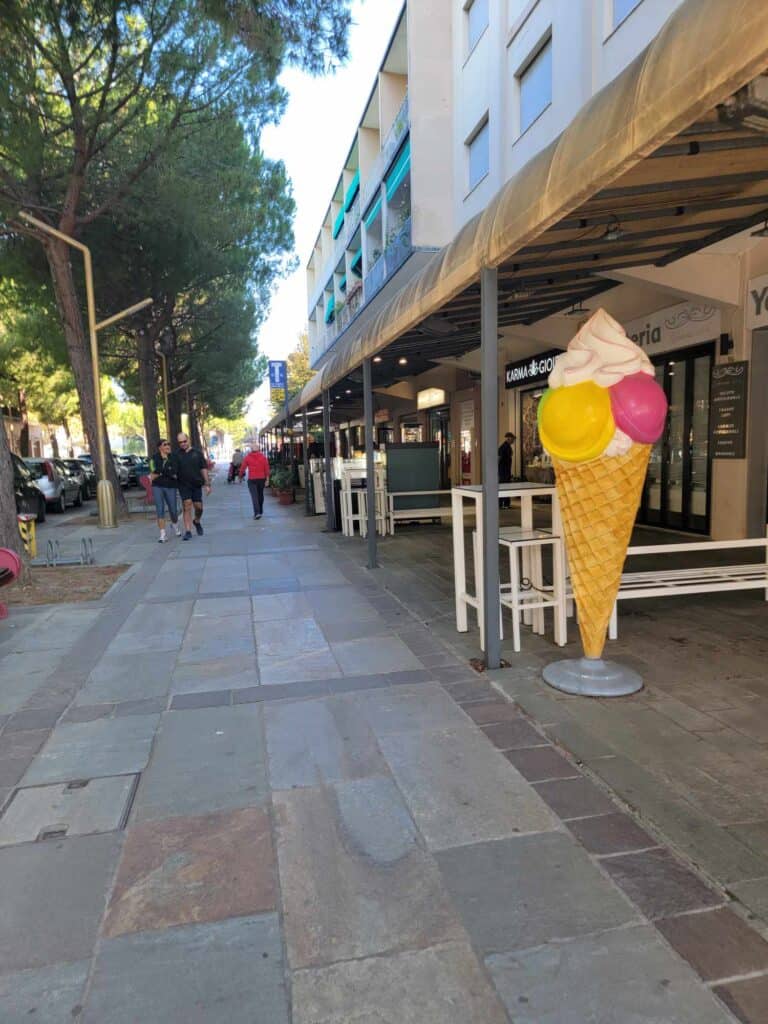
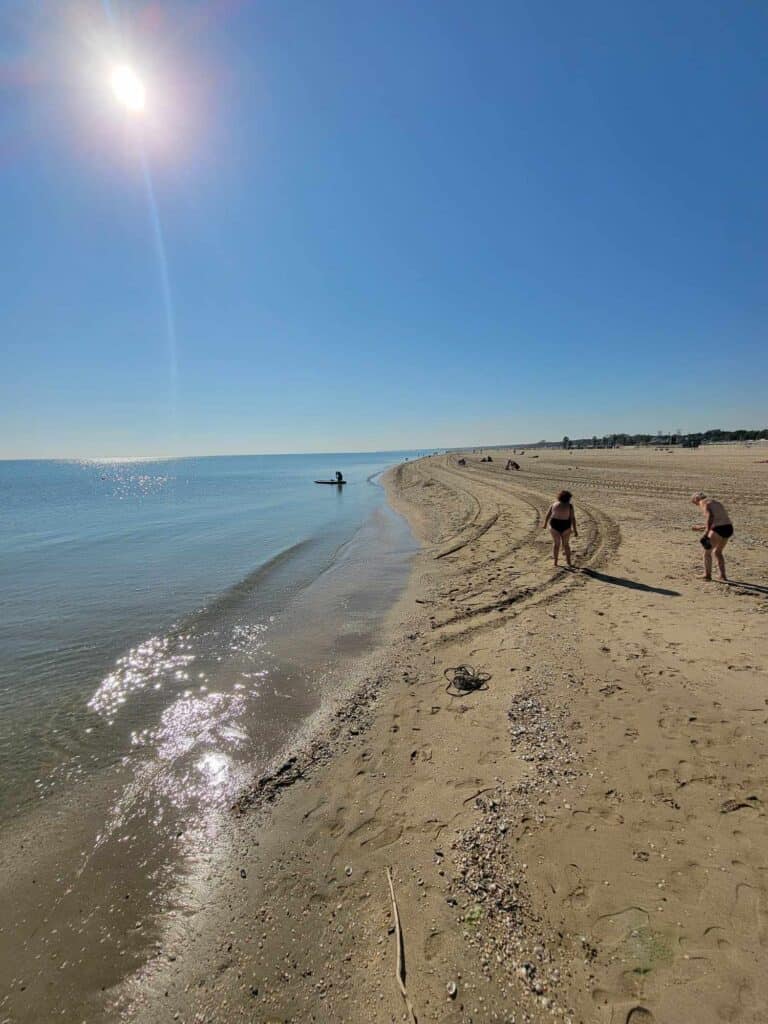
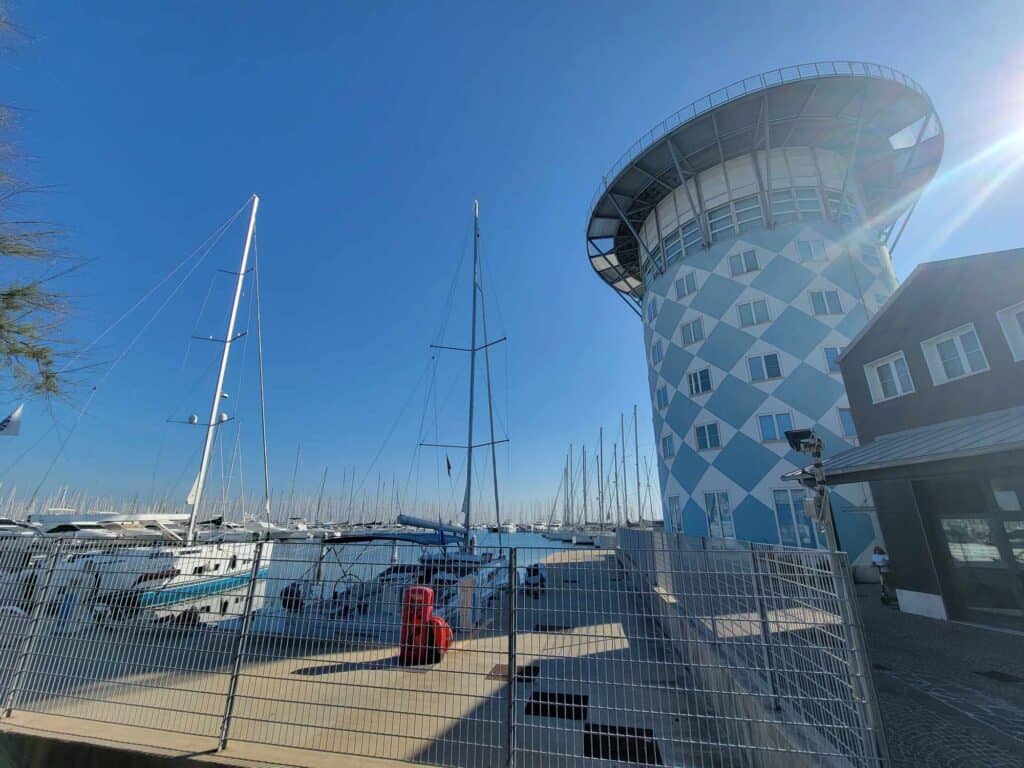
The sand at the adjacent beach is soft and golden and full of shells. It stretched as far as the eye could see – not like the crowded “beach clubs” we’d seen on the Amalfi side the week before. This was wide and clean and not crowded. It looked like a favorite with locals, and there were quite a few people fishing. We decided this would be a fabulous place to return some time for a beach vacation all on its own. And our dog loved sniffing the tideline and taking a little dip in the sea!
Eat Amazing Food
Osteria Passatelli
Italy is full of amazing food, and Ravenna is no exception. We had some of the best food of our 16-day trip here, including a “Dante Alighieri” pizza at the Osteria Passatelli. They have an English menu, but before you tell me that this means unequivocally it’s a tourist trap, read on. First, it was full of locals. We were the only English speakers there from what I could tell. Second, the Dante Alighieri pizza had: fresh buffalo mozzarella, roasted cherry tomatoes, Parma ham, basil pesto, burrata, honey, toasted almonds, and a drizzle of olive oil. Yeah.
Other notable menu items included a local cheese plate, and a local pasta called passatelli made of bread crumbs, eggs, and cheese. It is incredibly good and had a really interesting texture. Even if you have been to Italy you may not have experienced passatelli because it is fairly specific to the Emilia-Romagna region. I gorged myself and waddled back to the hotel. Totally worth it! (I dream of the Dante pizza!)
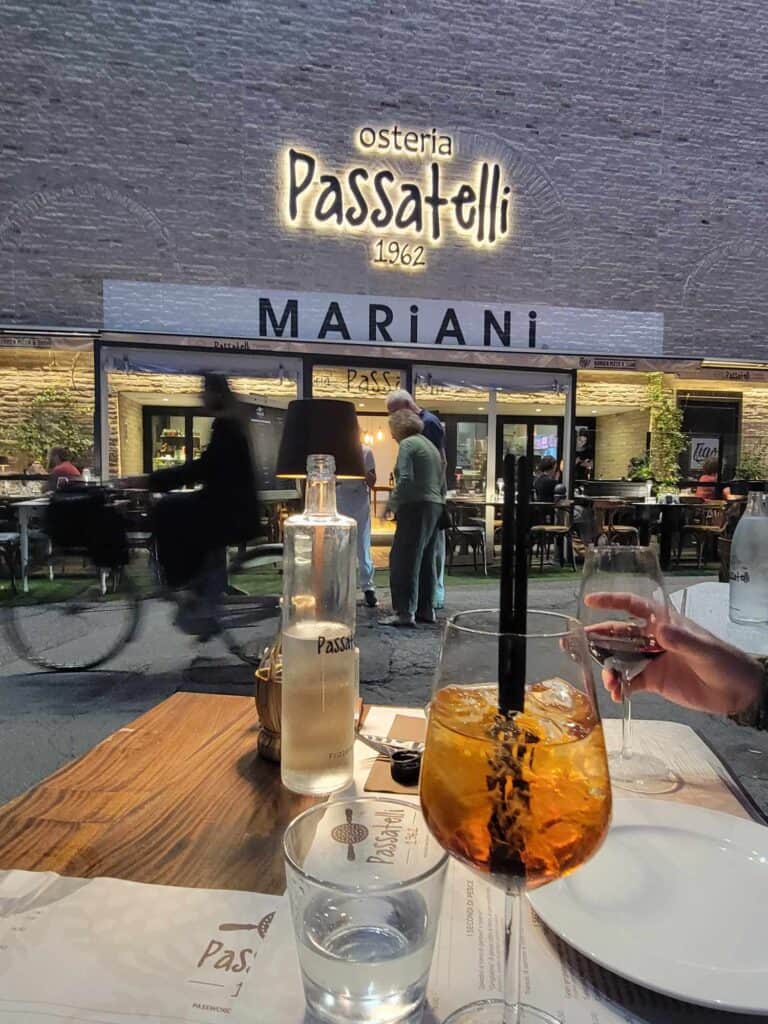
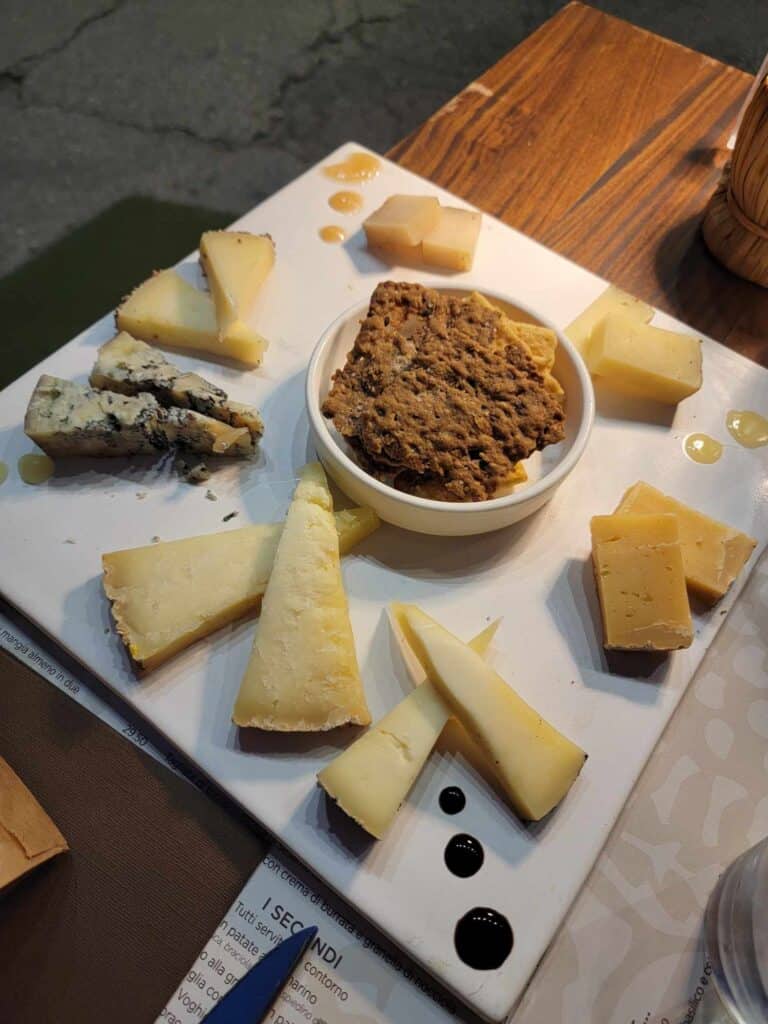
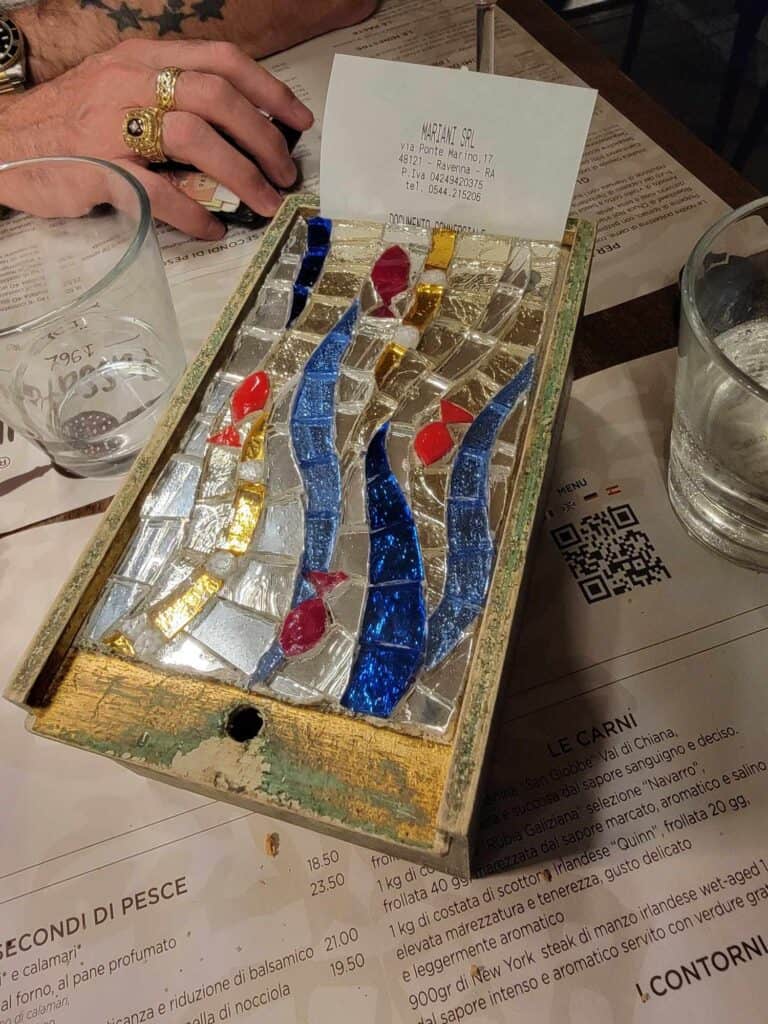
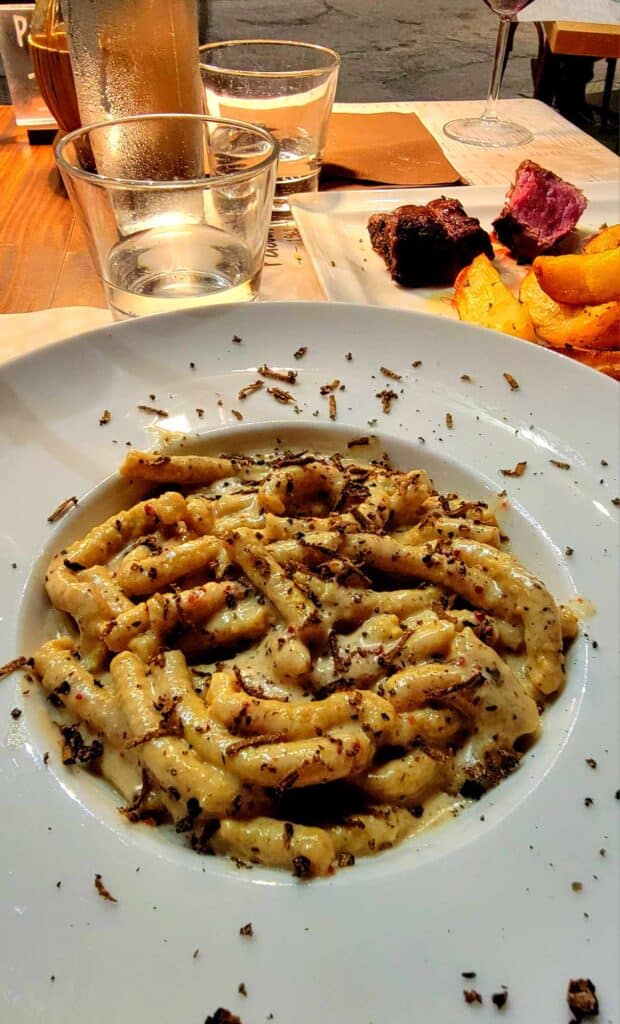
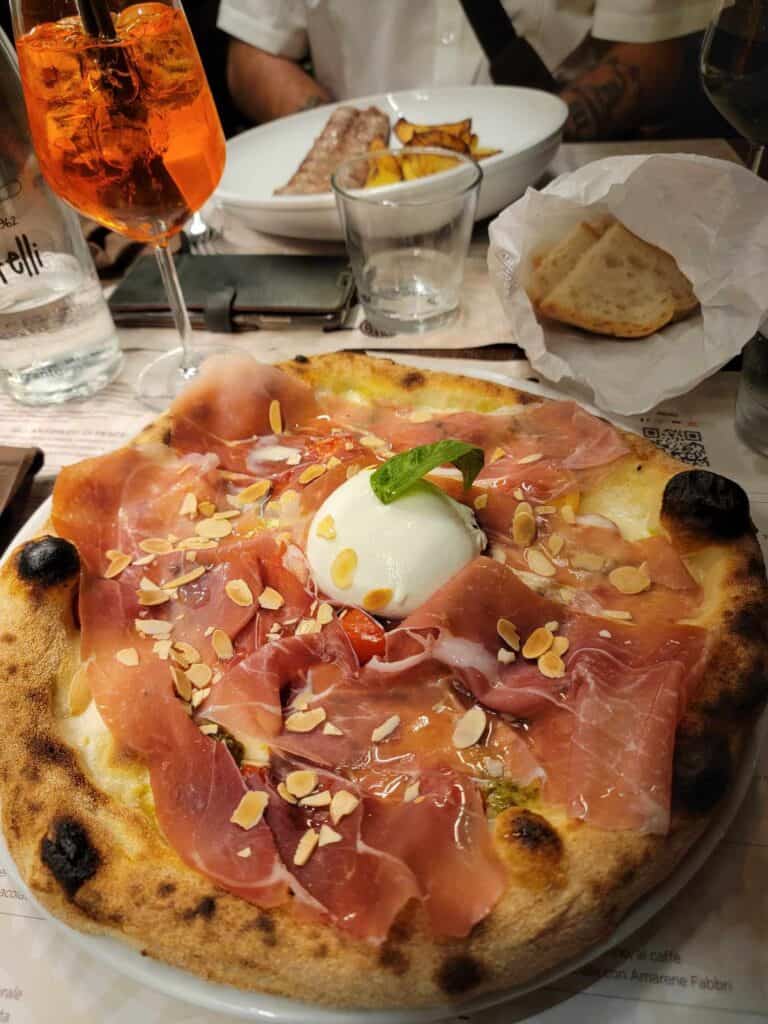
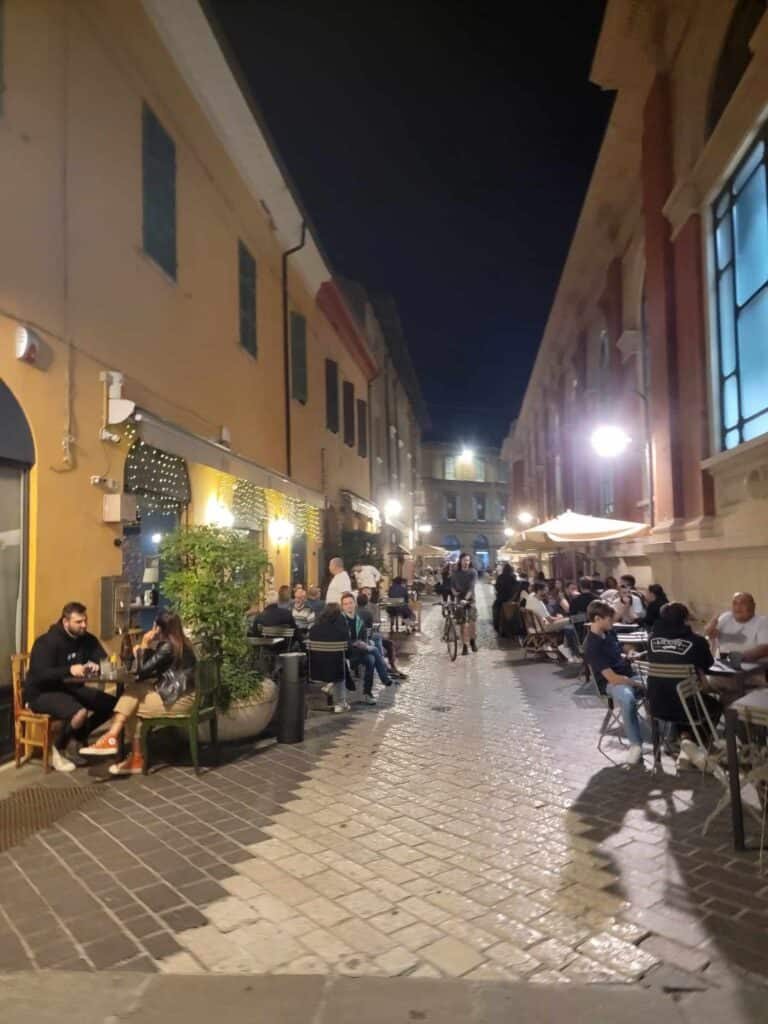
Ravenna Covered Market
Definitely take a half hour or so to browse the covered market! The market area has its roots in antiquity, at various times a center for fish markets, draperies, artisans’ workshops and more. In the Middle Ages it became a covered market and has been built and rebuilt on the same location since then.
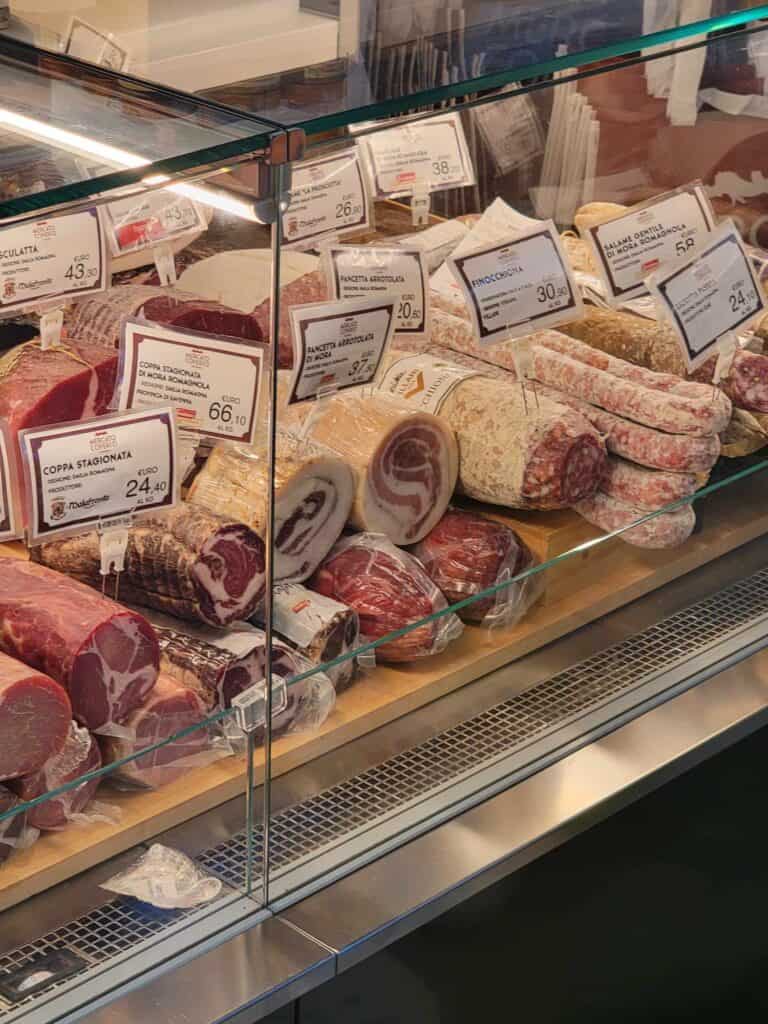
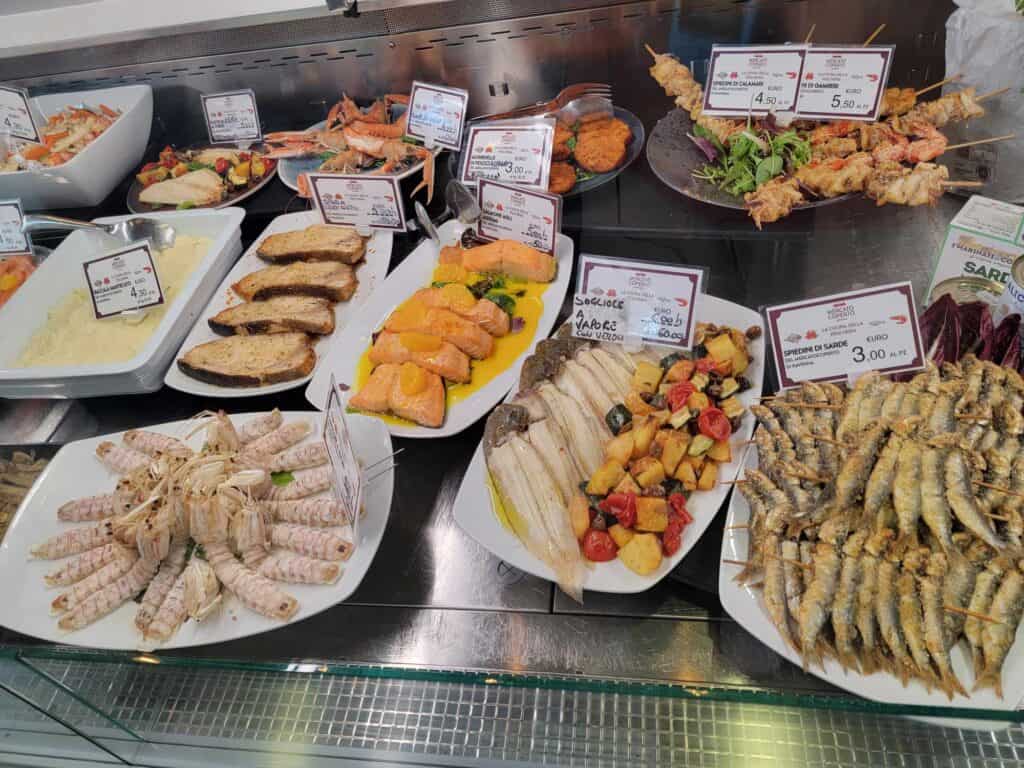
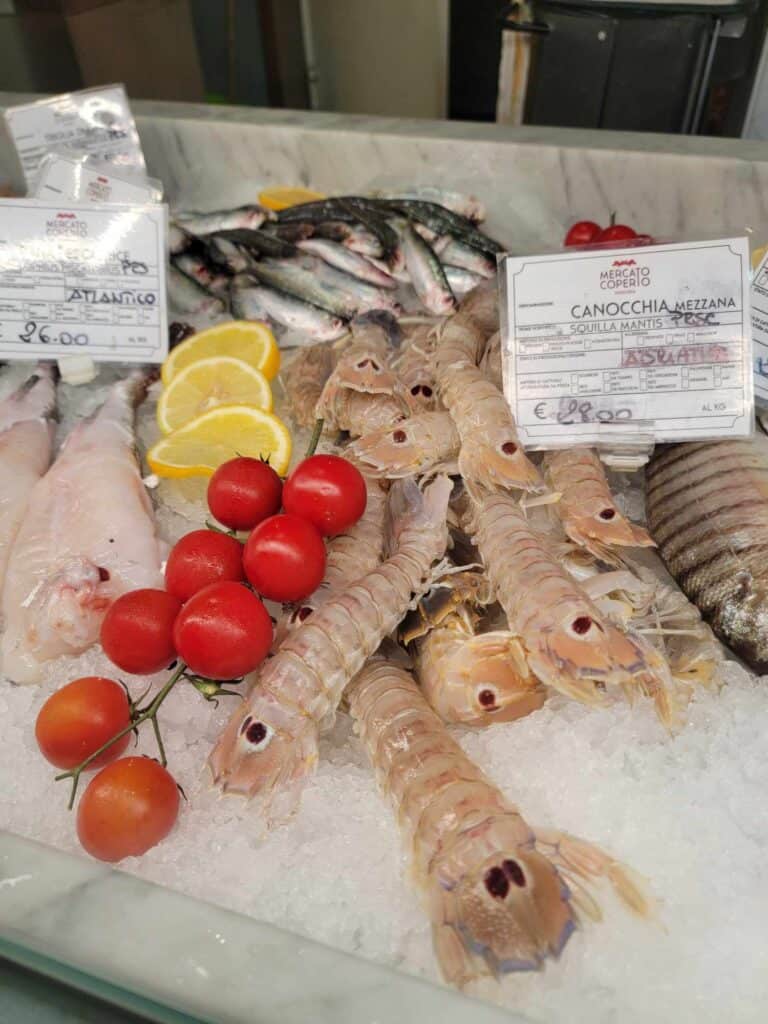
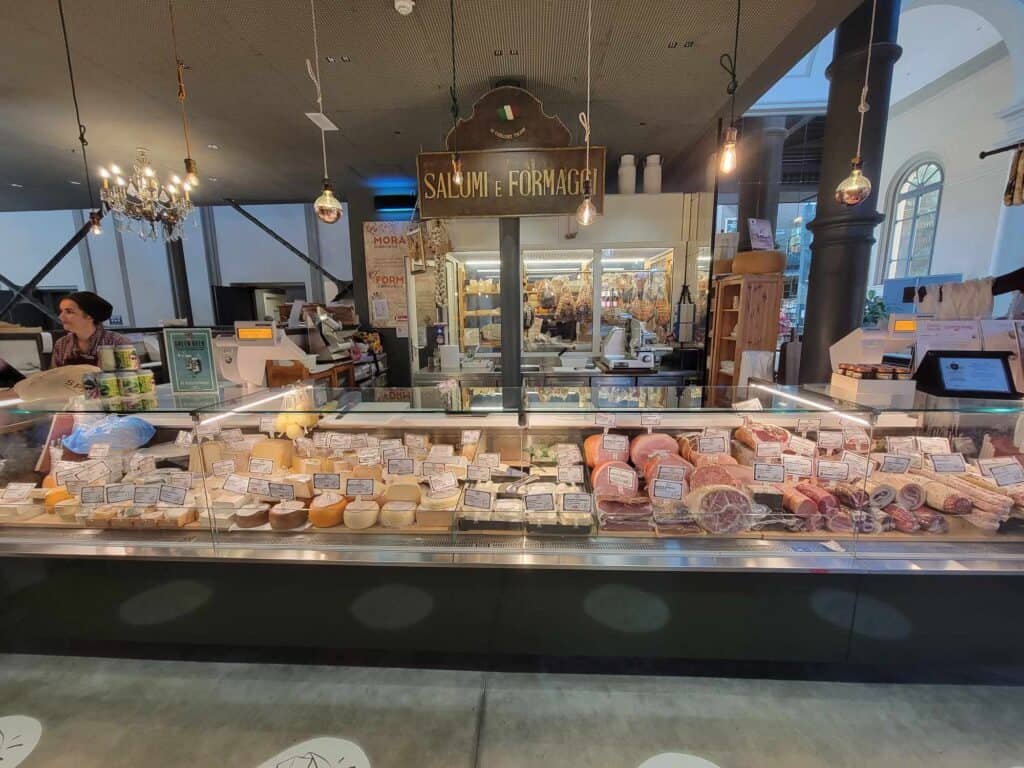
The new modern facility, finished in 2020 is a veritable treasure trove of local delicacies from the territory of Romagna. Inside you’ll find butcher shops, bakeries, seafood, cheese mongers, gelato, a cafeteria and two restaurants.
Cross the Rubicon
Ravenna is also where Julius Caesar amassed his legion of thousands to cross the river Rubicon after which he would have knowingly violated the law, and committed to all out war with Rome. And of course, we all know how that one turned out. Caesar was victorious and Rome was his – until it wasn’t.
If your Ravenna visit is part of a road trip, you will find the vestiges of the Rubicon south of there and just north of Rimini. We drove north to Ravenna from Ostuni, and crossing today via the highway isn’t nearly as eventful as it was for Caesar. But it’s still cool to be able to cross the Rubicon! Just for good measure you can yell out “The die is cast!” like Caesar did, as you cross the overpass!
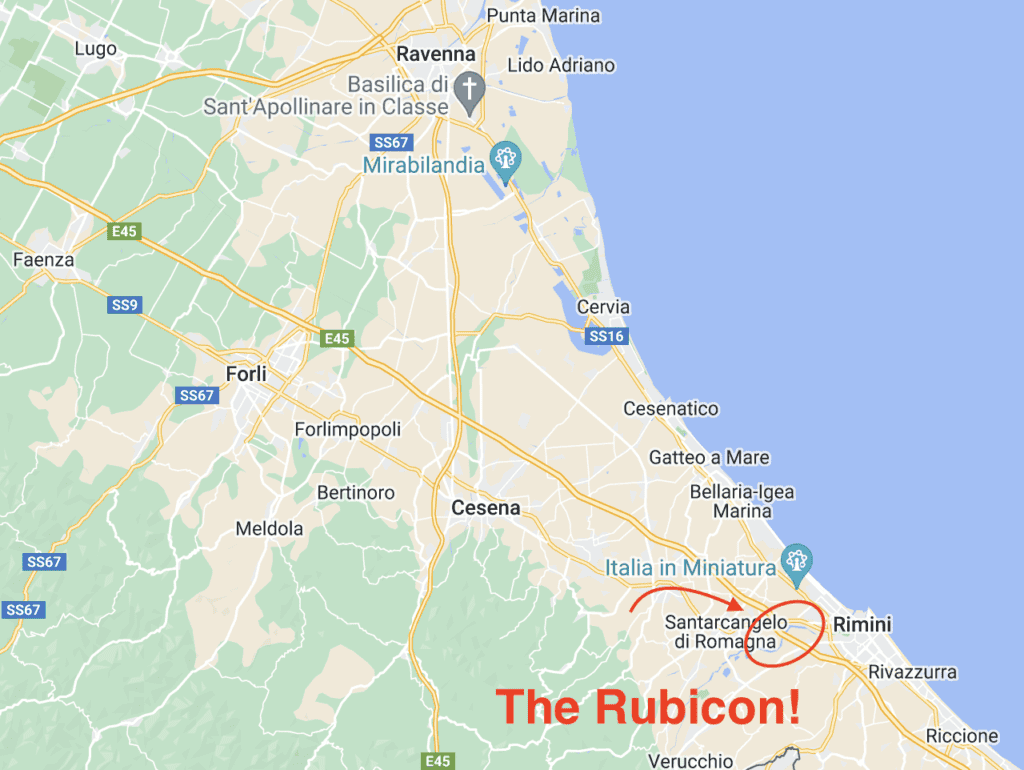
Don’t blink or you’ll miss it! There is a sign and an overpass on the highway. My how times have changed.
You can read the full post on our 16-day Italy road trip here.
Take it all in
Modern day Ravenna is a delight. Residents hold to, and celebrate their fascinating history, their status as a haven for the man who put the Italian language into world literature and changed the course of language itself. And everywhere you will see signs and artworks and markings made from mosaics. Art and literature are the hallmarks of this enchanting city. Just walking the streets in the historic center, window shopping, stopping for an aperitivo, and soaking in the atmosphere of this ancient city makes for a delightful day.
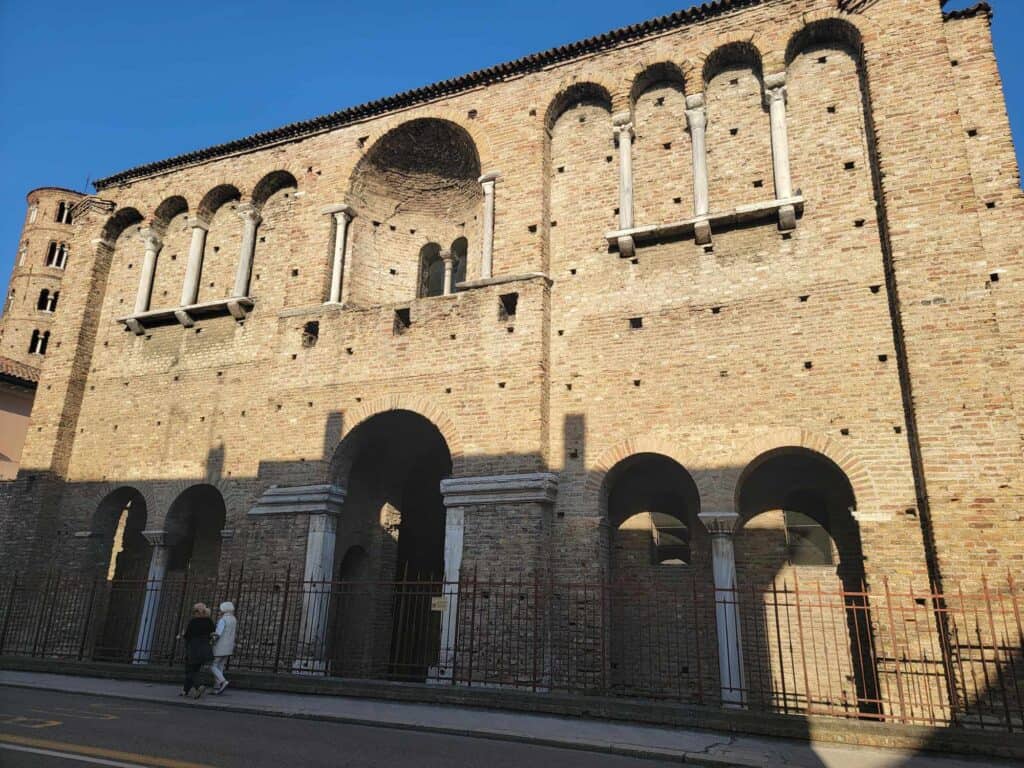
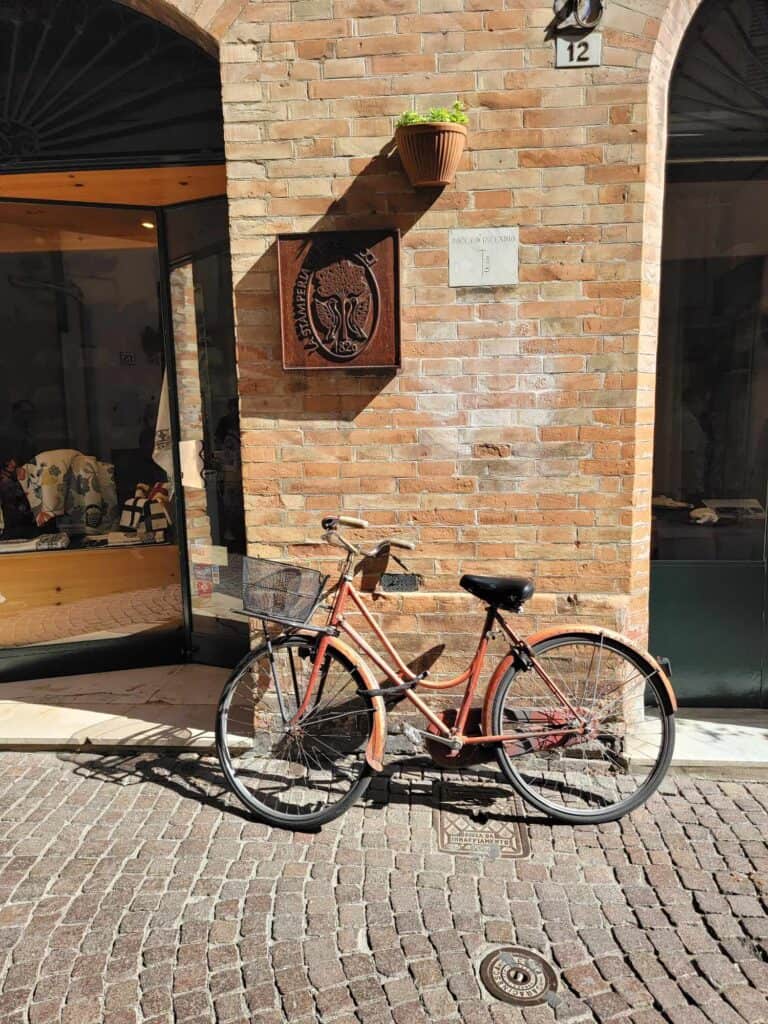
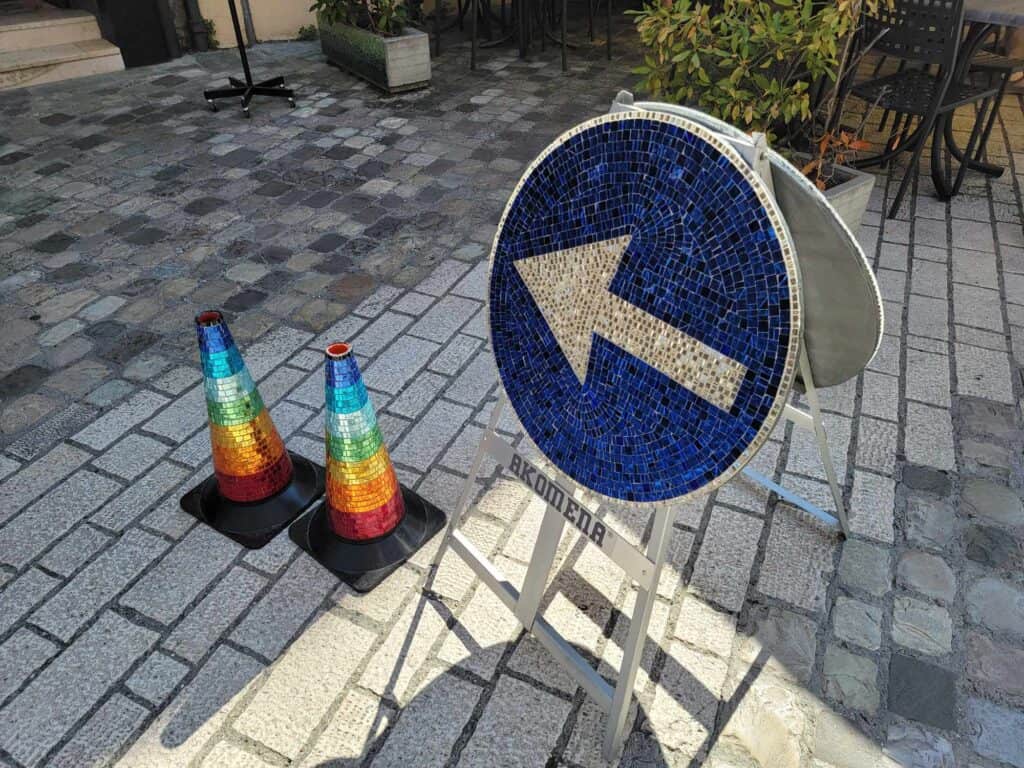
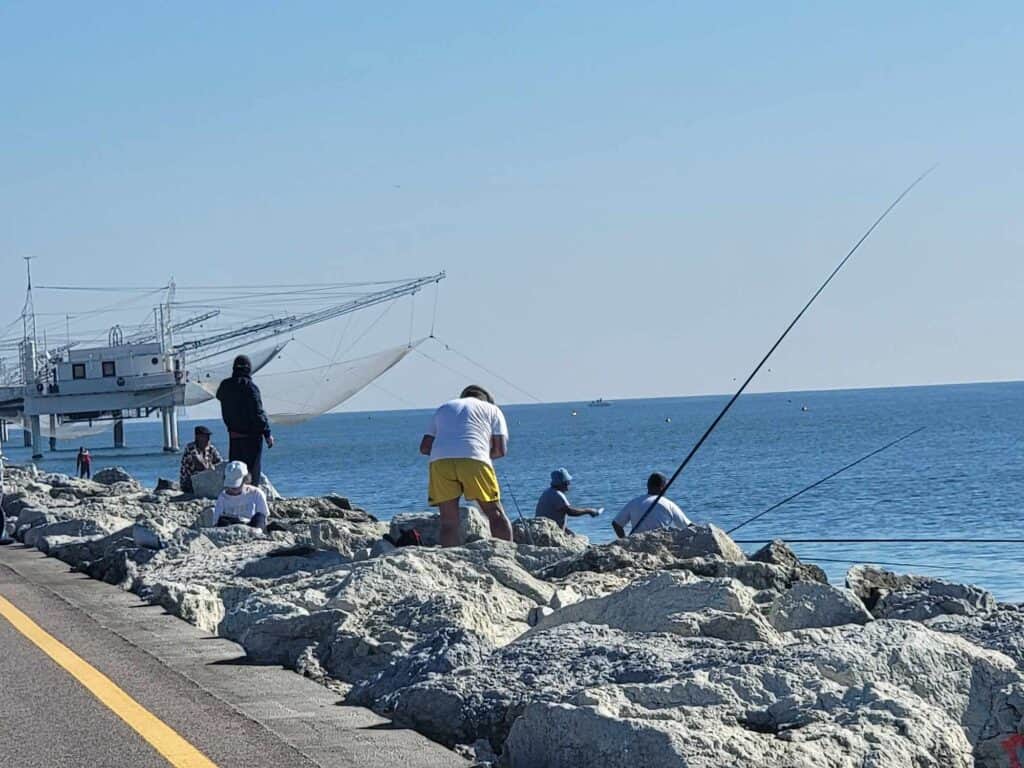
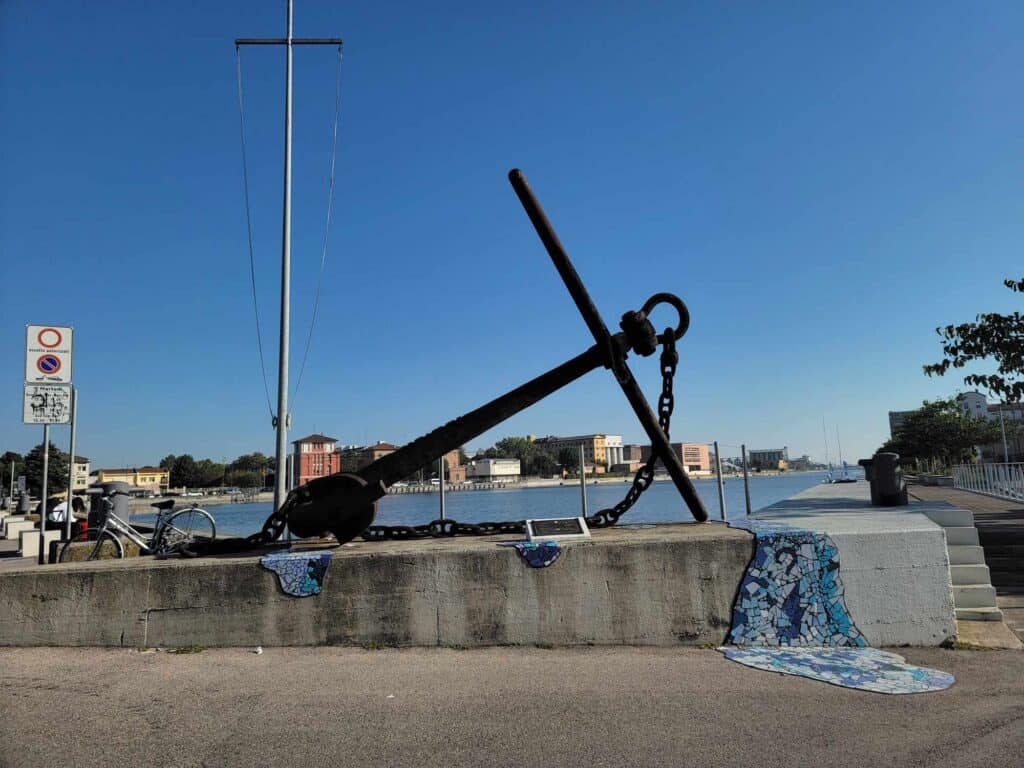
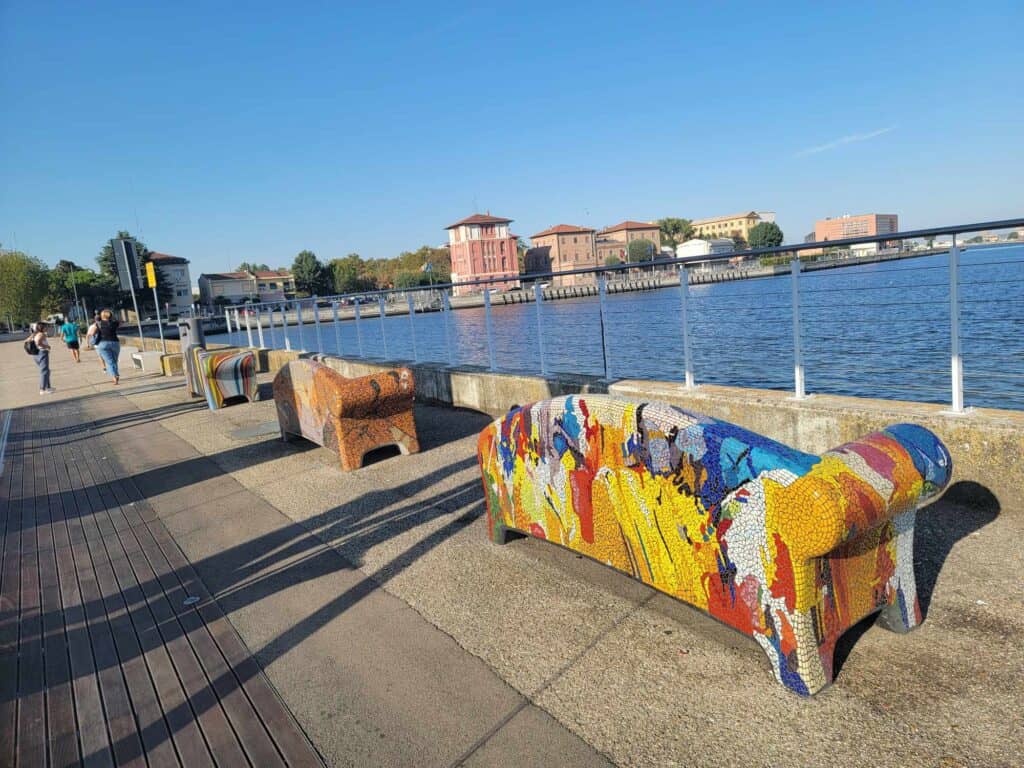
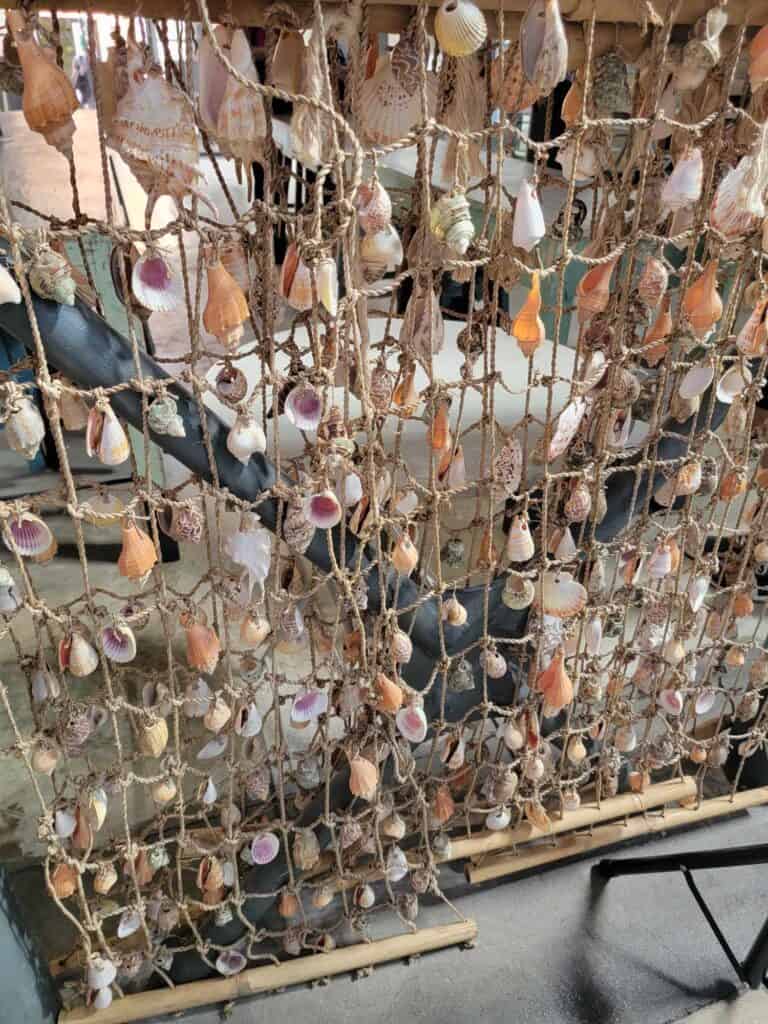
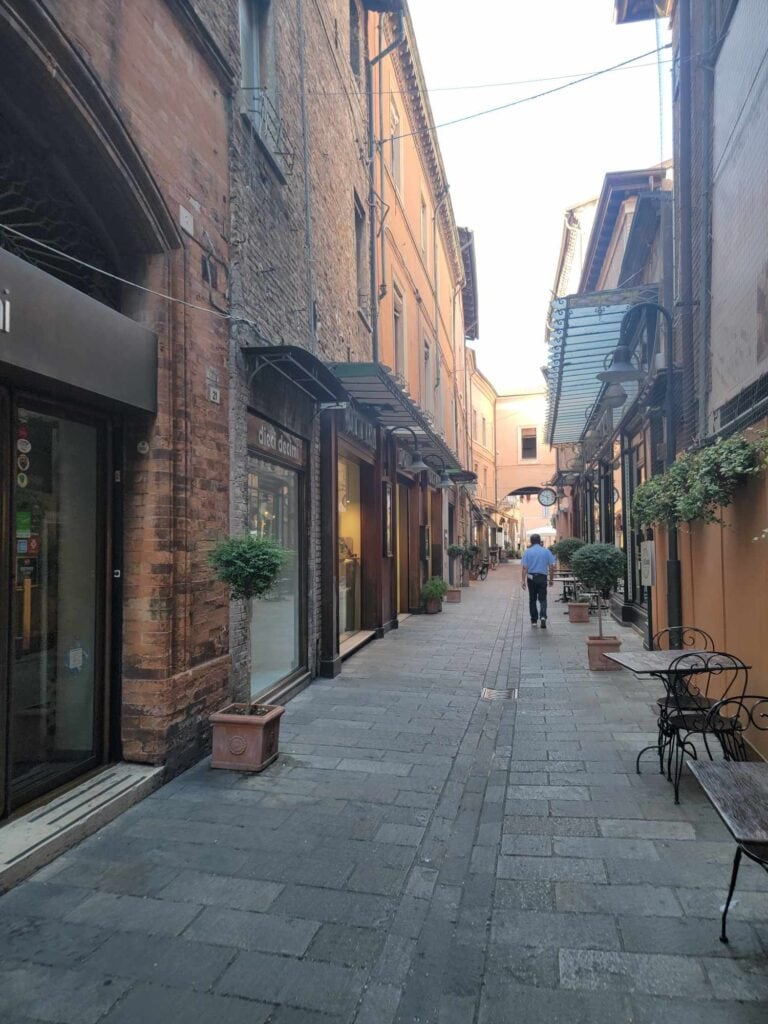
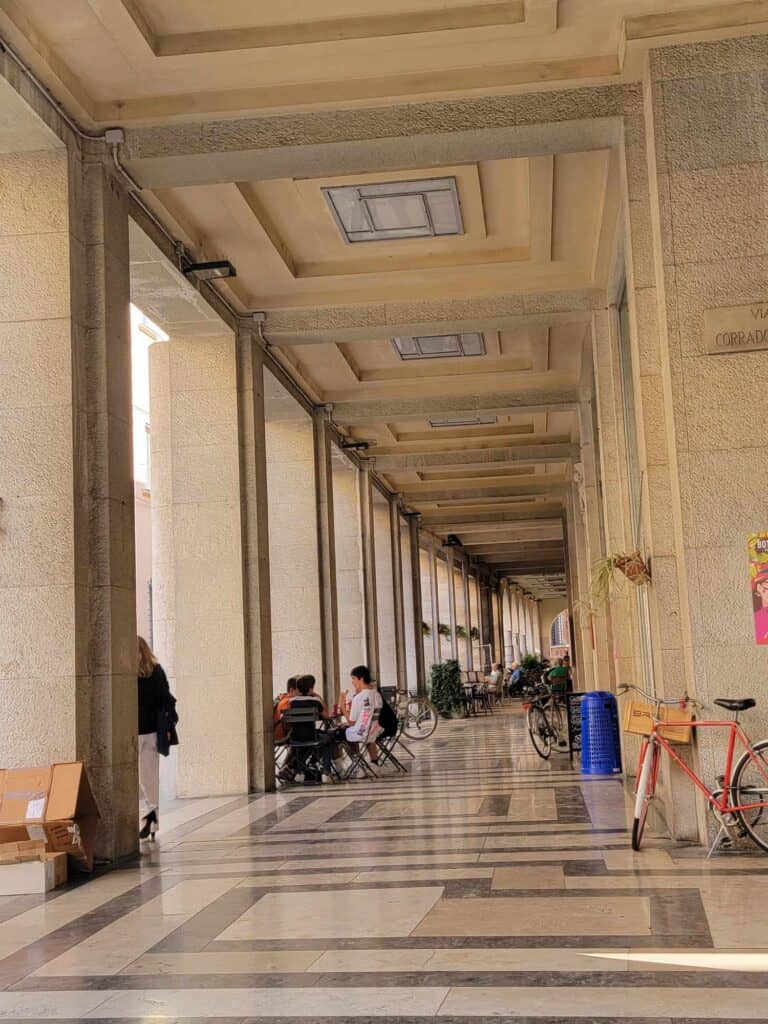
I should also mention that Ravenna is the most bicycle-filled city in Italy! We noticed right off the bat that there were fewer motorcycles than elsewhere in Italy, and tons of bikes. Not e-bikes either – the old fashioned kind with big baskets for groceries, small dogs, bottles of wine. There are art galleries, clothing boutiques and amazing shoe stores, and buildings and arches of ancient Roman brick. Scads of bakeries, gelaterias, and restaurants with incredible pasta, seafood, and steak. We passed by one unassuming brick building and then read the sign which said it was the remains of the palace of Theodoric, King of the Goths. *jaw drops silently*
Ravenna in One Day
Of course, there’s enough in Ravenna to keep you busy for much more than a day, but here’s the best use of your time if that’s all you’ve got!
*This tour of Ravenna in one day will earn you approximately 20,000 steps if you do it all by foot.
- Breakfast at Caffè Pasticcheria
- 10:10 Meet your tour right there in front of Dante’s church
- Tour ends at 1:30ish
- Stop for a quick bite and gelato at the covered market
- Go to the Dante Museum and Library (the church and tomb will already be covered during your tour) OR go to one of the other mosaic sites
- Hit a couple gift shops, window shop, and just soak it in
- Zip to the beach, beachcomb, enjoy the atmosphere
- Back to town for an amazing dinner at Osteria Passatelli! (Do the Dante! You’ve already burned it off!)
Top Tips:
- Don’t forget to bring a 1Euro coin to light up the flooded fish crypt!
- Stay hydrated, especially if it’s hot. This is a bunch of walking with a lot to see that might distract you
- Stretch your neck. Yes, I did get a neck cramp from looking up so much!
- Wear comfortable walking shoes – tried and tested
I absolutely guarantee your experience in Ravenna will be unforgettable, and you’ll wonder like I do why more people don’t have this place on their bucket lists. Shhhh… maybe it’s better that way!
You Might Also Enjoy These Posts:
- Epic 16-Day Italy Road Trip With Your Dog
- Pompeii vs. Herculaneum: Best Tips and Biggest Differences
- The 7 Most Amazing Things to Do in Ravello Italy
- Ostuni the White City is Your Gateway to Puglia
- Villa Cimbrone Gardens in Ravello – Heaven on Earth
- Why Matera, the Oldest City in Italy, Blew My Mind
- Ravenna, Italy – Ultimate One-Day Itinerary!
- Is Pisa Worth Visiting?
- Staying at Magnificent Hotel Miramare Stabia with Your Dog – a Review
- Spectacular Hotel Villa Amore Ravello – a Dog-Friendly Hotel Review
